Paul van Yperen's Blog, page 224
August 27, 2019
Giani Esposito
Giani Esposito aka Gianni Esposito (1930-1974) was a Belgian actor, singer/songwriter and poet. He appeared in 50 films between 1951 and 1973.
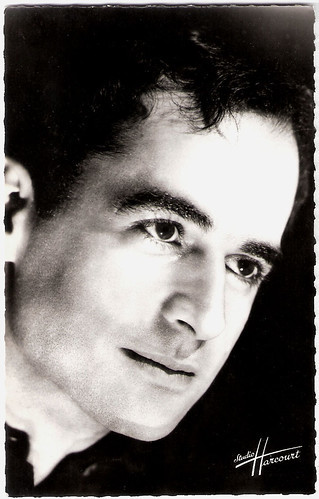
French postcard by Editions du Globe, Paris, no. 697. Photo: Studio Harcourt.
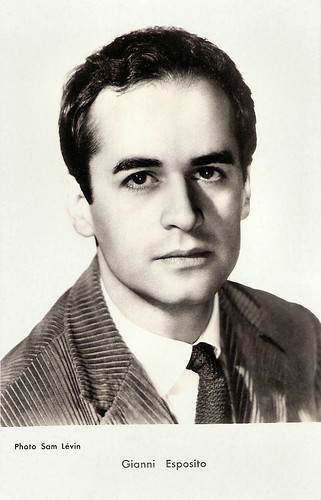
French postcard by Editions P.I., Paris offered by Les Carbones Korès "Carboplane", no. 1059A. Photo: Sam Lévin.
French Cancan
Giani Esposito was born in Ixelles/Elsene, in the south of Brussels, in 1930. His father was Italian, his mother French. Later, his family moved to Paris and between 1939 and 1949, he grew up in Italy.
In 1951, Esposito became an actor in French cinema, starting with a bit part as a Jewish passenger in Maitre après Dieu/Skipper Next to God (Louis Daquin, 1951) starring Pierre Brasseur .
Around the same time he started a singing career, performing at the cabarets La Rose Rouge and L'Ecluse, and in 1957 he had success with the song Le Clown. From 1958 on he made several records with his texts and songs. He also published some books and made illustrations.
Meanwhile he appeared in supporting parts in such films as the Jean-Paul Sartre adaptation Huis clos/No Exit (Jacqueline Audry, 1954), the musical French Cancan (Jean Renoir, 1955) starring Jean Gabin , Les mauvaises rencontres/Bad Liaisons (Alexandre Astruc, 1955) with Anouk Aimée , and Les misérables/Les Misérables (Jean-Paul Le Chanois, 1957-1958) based on the book by Victor Hugo.
In 1959 he met Pascale Petit who became his partner. In 1966 their daughter Douchka Esposito was born.
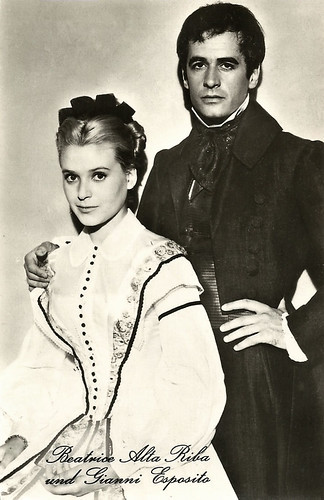
East-German postcard by VEB Progress. Photo: DEFA. Béatrice Altariba and Esposito played Cosette and Marius in Les misérables (Jean-Paul Le Chanois, 1957-1958).
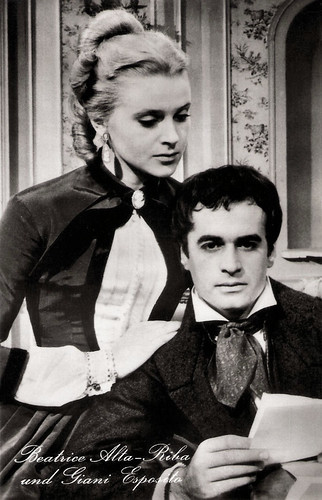
East-German postcard by VEB Progress Film-Vertrieb, no. 951, 1958. Photo: DEFA. Publicity still for Les misérables (Jean-Paul Le Chanois, 1957-1958) with Béatrice Altariba as Cosette and Giani Esposito as Marius. The film was a co-production of DEFA (East-Germany), P.A.C. (France), Serena (Italy) and Société Nouvelle Pathé Cinéma (France).
The Decameron
Until 1971, Giani Esposito played roles in many French films, including Paris nous appartient/Paris Belongs to Us (Jacques Rivette, 1960), the two-part experiment Françoise ou La vie conjugale/Anatomy of a Marriage (André Cayatte, 1964) featuring Marie-José Nat , and its sequel Jean-Marc ou La vie conjugale/Anatomy of a Marriage (André Cayatte, 1964) featuring Jacques Charrier .
He also worked in Italy and had a part in Il Decameron/The Decameron (Pier Paolo Pasolini, 1971), based on the novel Il Decameron by Giovanni Boccaccio. It was the first film in Pasolini's Trilogy of Life.
Between 1957 and 1973 Esposito played in various telefilms and television series. His final TV film was the romance L'enchantement/The enchantment (Robert Mazoyer, 1974) with Nicole Courcel .
In 1971 Esposito met Ersie Pittas, niece of the Greek director Michael Cacoyannis, and left his wife and daughter. With Pittas he started a show in which he recited poems while she danced, touring around France in 1972-1973.
While having an overload of projects and plans Giani Esposito was struck by a viral hepatitis and a brain tumour in late 1973, and died in Neuilly-sur-Seine, on New Year's Day 1 January 1974.
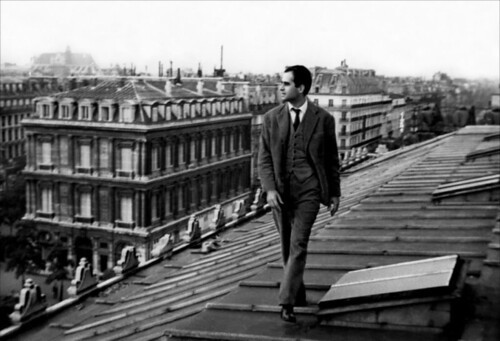
Photo of Paris nous appartient/Paris Belongs to Us (Jacques Rivette, 1960). Collection: The Island of Cinema @ Flickr.
Giani Esposito sings Le Clown. Source: Pierre M. Lavallée (YouTube).
Sources: Passage Giani Esposito (French), Wikipedia (French) and .

French postcard by Editions du Globe, Paris, no. 697. Photo: Studio Harcourt.

French postcard by Editions P.I., Paris offered by Les Carbones Korès "Carboplane", no. 1059A. Photo: Sam Lévin.
French Cancan
Giani Esposito was born in Ixelles/Elsene, in the south of Brussels, in 1930. His father was Italian, his mother French. Later, his family moved to Paris and between 1939 and 1949, he grew up in Italy.
In 1951, Esposito became an actor in French cinema, starting with a bit part as a Jewish passenger in Maitre après Dieu/Skipper Next to God (Louis Daquin, 1951) starring Pierre Brasseur .
Around the same time he started a singing career, performing at the cabarets La Rose Rouge and L'Ecluse, and in 1957 he had success with the song Le Clown. From 1958 on he made several records with his texts and songs. He also published some books and made illustrations.
Meanwhile he appeared in supporting parts in such films as the Jean-Paul Sartre adaptation Huis clos/No Exit (Jacqueline Audry, 1954), the musical French Cancan (Jean Renoir, 1955) starring Jean Gabin , Les mauvaises rencontres/Bad Liaisons (Alexandre Astruc, 1955) with Anouk Aimée , and Les misérables/Les Misérables (Jean-Paul Le Chanois, 1957-1958) based on the book by Victor Hugo.
In 1959 he met Pascale Petit who became his partner. In 1966 their daughter Douchka Esposito was born.

East-German postcard by VEB Progress. Photo: DEFA. Béatrice Altariba and Esposito played Cosette and Marius in Les misérables (Jean-Paul Le Chanois, 1957-1958).

East-German postcard by VEB Progress Film-Vertrieb, no. 951, 1958. Photo: DEFA. Publicity still for Les misérables (Jean-Paul Le Chanois, 1957-1958) with Béatrice Altariba as Cosette and Giani Esposito as Marius. The film was a co-production of DEFA (East-Germany), P.A.C. (France), Serena (Italy) and Société Nouvelle Pathé Cinéma (France).
The Decameron
Until 1971, Giani Esposito played roles in many French films, including Paris nous appartient/Paris Belongs to Us (Jacques Rivette, 1960), the two-part experiment Françoise ou La vie conjugale/Anatomy of a Marriage (André Cayatte, 1964) featuring Marie-José Nat , and its sequel Jean-Marc ou La vie conjugale/Anatomy of a Marriage (André Cayatte, 1964) featuring Jacques Charrier .
He also worked in Italy and had a part in Il Decameron/The Decameron (Pier Paolo Pasolini, 1971), based on the novel Il Decameron by Giovanni Boccaccio. It was the first film in Pasolini's Trilogy of Life.
Between 1957 and 1973 Esposito played in various telefilms and television series. His final TV film was the romance L'enchantement/The enchantment (Robert Mazoyer, 1974) with Nicole Courcel .
In 1971 Esposito met Ersie Pittas, niece of the Greek director Michael Cacoyannis, and left his wife and daughter. With Pittas he started a show in which he recited poems while she danced, touring around France in 1972-1973.
While having an overload of projects and plans Giani Esposito was struck by a viral hepatitis and a brain tumour in late 1973, and died in Neuilly-sur-Seine, on New Year's Day 1 January 1974.

Photo of Paris nous appartient/Paris Belongs to Us (Jacques Rivette, 1960). Collection: The Island of Cinema @ Flickr.
Giani Esposito sings Le Clown. Source: Pierre M. Lavallée (YouTube).
Sources: Passage Giani Esposito (French), Wikipedia (French) and .
Published on August 27, 2019 22:00
August 26, 2019
L'Occident (1928)
The French silent film L'Occident/The West (Henri Fescourt, 1928) was based on a play by Henri Kistemaeckers. He also scripted the film which is partly situated in Morocco. In the leading role Jaque Catelain plays a French lieutenant who, during the war between the French foreign legion and the Moroccans, falls in love with a Moroccan woman. L'Occident was part of the wave of French Orientalist films after the success of Jacques Feyder's L'Atlantide (1921).

French postcard by Europe. Photo: publicity still of L'Occident (Henri Fescourt, 1928). The card makes publicity for the film's premiere screening at the Paris cinema Marivaux. Caption from La Petite Illustration, 398, 1928: "Hassina joins Taïeb into a deserted room."

French postcard by Europe. Photo: publicity still of L'Occident (Henri Fescourt, 1928). The card makes publicity for the film's premiere screening at the Paris cinema Marivaux. Caption: La fuite des pillards (The Escape of the Looters). The left side of the card was printed out of focus.
Exotic melodrama
In L'Occident/The West (Henri Fescourt, 1928), a French squadron before the coast of Morocco tries to prevent rebel gangs from attacking the caravans but is afraid to kill loyal citizens by bombing. So Captain Jean Cadière (Lucien Dalsace), who knows the local language and customs, is sent on a secret mission. He also substitutes for his young protégé, lieutenant Arnaud de Saint-Guil ( Jaque Catelain ).
The next morning, Hassina (Claudia Victrix), a captive of the tribe of Zerreth-Hama, finds Cadière at a well, bitten by a snake. Because of an old prediction, she believes he is her chosen one, so she saves him by sucking out his poison, considers him her master, and brings his papers to the French vessel. Arnaud is impressed by the mysterious woman.
The tribe leader, Taïeb (Hugues de Bagratide), discovers his stallion has been used and female traces are found, but only Hassina's little sister Fathima (Andrée Rolane) is discovered. When Taïeb threatens to burn Fathima if Hassina and Cadière don't come out, and his men attack the couple, the marine starts to fire its guns. The tribe flees, but Taïeb manages to kidnap Fathima. The wounded Hassina is taken away, while the French soldiers lift their guns in homage. Hassina is taken to Toulon, deplores the loss of her sister and understands her lover is a roumi, a French soldier.
Cadière takes Hassani to the vast villa of his aunt Aline (Jane Méa), who adopts her, learns her French and music, but Hassani remains quiet and unhappy. She has gotten a note that the roumi killed her sister, so she is torn between her family and her new lover. Instead, Fathima is not dead but also in Toulon, forced by Taïeb to dance every night in a den. When one night he treats her brutally, sailors, among whom Le Goff, an aid of Cadière, defend her.
Meanwhile, Arnaud is troubled, not only because he is fed up with the army, but also because he is passionately in love with Hassina and hates Cadière. At the betrothal party of Cadière and Hassani, Taïeb appears in disguise and pushes Hassani to avenge her sister, but her love is bigger than her desire for revenge. Arnaud leaves the army. Cadière's aid Le Goff finds Fathima and Taïeb, and after a struggle, the Moroccan confesses his crimes. Cadière himself prevents Arnaud of abducting Hassani and appeals to his conscience, so the latter returns to the army and abstains from committing a crime. Cadière also renders Hassani her sister, so that all ends well.
This exotic melodrama was based on a play by Henri Kistemaeckers, who also scripted the film. The film was produced by Société des Cinéromans, and distributed by Pathé Consortium Cinéma. Sets were by Robert Gys. L'Occident/The West was filmed in 1927, but premiered in France on 26 September 1928 at the Paris cinema Marivaux. The postcards in this post all make publicity for the film's premiere screening at the Marivaux.
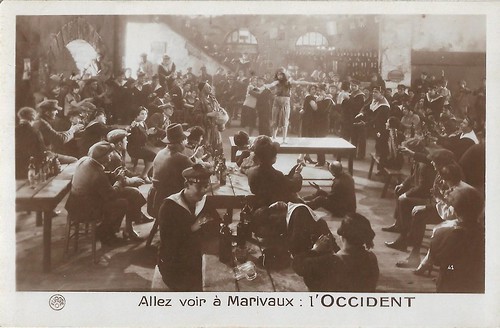
French postcard by Europe. Photo: publicity still of L'Occident (Henri Fescourt, 1928). Caption from La Petite Illustration, 398, 1928: "Taïeb forces young Fathima to dance in a den in Toulon."
Tout Paris
The French magazine Cinémagazine wrote about the first night: "It was a great first. Marivaux welcomed Tout-Paris in a brand new auditorium, with new painting and armchairs. They presented L'Occident/The West.
This film, the first part of which was set in Morocco, had to be Moroccan, it was not only by its images, but also by the Nuba and the trumpets of the 6th and the 24th regiment of Spahis who, on the stage, let us hear the most ardent marches of their vibrant repertoire, which thrilled all those who were cavaliers of spahis ... even when, like me, they became territorial.
In the armchairs, on the balcony, in the boxes, Tout-Paris: artists, people of the world, journalists and writers - shimmering toilets, tuxedos or black clothes.
Mr. Painlevé, Minister of War, and General Carence seemed to encourage all the directors of the West to show our soldiers the 'wheat' in action while in his chair, Mr. Steeg, resident general of France in Morocco, talked about the fruits of the efforts by Drude, Amade, and Lyautey.
General Decoin, commanding the division of Spahis at Compiegne, could not find any criticism for the charge of spahis carried on the screen, while Charles Pathé, in the box of M. Sapene, applauded the Provence in action. In short, a beautiful auditorium, a chic room - a room of a grand first night."
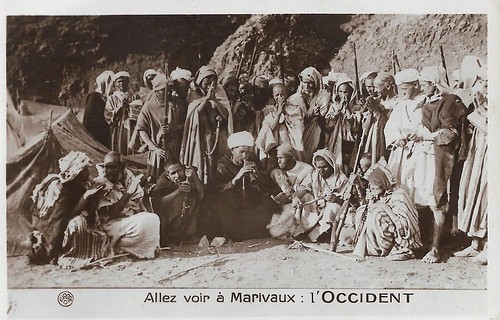
French postcard by Europe. Photo: publicity still of L'Occident (Henri Fescourt, 1928). The card makes publicity for the film's premiere screening at the Paris cinema Marivaux. Caption from La Petite Illustration, 398, 1928: "The hour of prayer of the tribe of Zerrath-Hama."
Fading on words of forgiveness and sweetness
On the film itself, Cinémagazine wrote: "Mr. Henry Kistemaeckers has somewhat modified the script of his play, 'The West', created by Suzanne Desprez, which was already shot by Capellani with Nazimova . (...) The film ends with a wedding or an American kiss, which could have been frankly ridiculous, but the last image fades on words of forgiveness and sweetness, heavy with fatality and love, a prelude to other words (...)
Claudia Victrix played Hassina. A heavy task to be true. This artist, rich in intelligent sensitivity, succeeded in conveying the conflict of the Moroccan primitive torn between her love for the roumi, her conqueror, and the atavism of her race. Towards her, Jaque Catelain , a young lieutenant, proves to be tender, while Lucien Dalsace plays a bitter, violent officer, fearless, and without reproach.
H. de Bagratide, a past master in the art of make-up, deserves a special mention for his composition of the role of Taïeb. Paul Guidé, was able to command the battleship Provence with authority and Renée Veller, one of the winners of the last contest of Cinémagazine, as a painful fiancee shows us an upset face - which is beautiful.
The little Andrée Rolane, already so appreciated, embodies gracefully the character of Fathima, the young sister of Hassina. Let's also quote Mrs. Jeanne Méa, Mrs. Liévin, Terrore, Labry, Raymond Guérin. But among the performers of the film, it would be unfair not to mention our sailors, our spahis, the Senegalese riflemen, and the men of the foreign legion who, in an admirably settled fight, jostled Taieb's looters.
The staging is by Henri Fescourt, a master to whom we owe Les Miserables. It deserves to be praised. The fight, as we have said, is admirable of truth, but the director also knew how to use the constructions of the fleet, their guns pointing in the sky, of their life finally to make intensely a work where those of the hinterland play such a beautiful role. Finally, in the first part, there are Moroccan landscapes that recall the most beautiful shots of Les Miserables." (Cinémagazine N° 40, 5 October 1928).
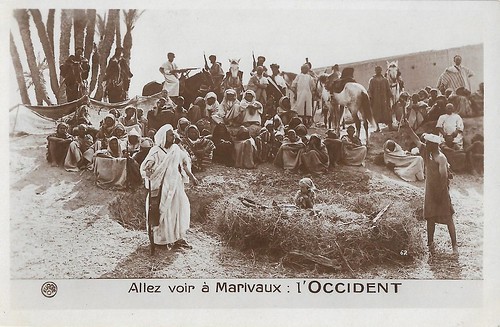
French postcard by Europe, no. 62. Photo: publicity still of L'Occident (Henri Fescourt, 1928). Caption from La Petite Illustration, 398, 1928: "The caïd Taïeb has decided to burn alive young Fathima."
Colonial, stereotypical and Western ideology
But how do modern critics react to L'Occident? In his book 'French Cinema: The First Wave, 1915-1929', Richard Abel was quite critical about the colonial, stereotypical and Western ideology of the film, in which one of the questions is whether an Oriental woman can become a Western woman, while the lead is played by a Western actress (and Abel wasn't convinced of Victrix' play).
Years after, director Fescourt himself recognised that none of the directors of the climactic battle scene - filmed in "the best western style" as Abel writes - asked themselves at the time whether the local extras playing the retreating Moroccan crowds might have been unhappy with their roles.
Abel situates L'Occident within the wave of French Orientalist films after the success of L'Atlantide (Jacques Feyder, 1921), with such examples as Visages voilés... âmes closes/The Sheik's Wife (Henry Roussel, 1921), Le Sang d'Allah/The Blood of Allah (Luitz-Morat, Alfred Vercourt, 1922), Sables/Sands (Dimitri Kirsanoff, 1927), and Maman Colibri/Mother Hummingbird (Julien Duvivier, 1929).
He also notes that it is remarkable that - possibly led by the negative public reactions to the war - French silent filmmakers hardly treated the war between the French foreign legion and the Moroccans, ending with the surrender of the Riftians in 1926.
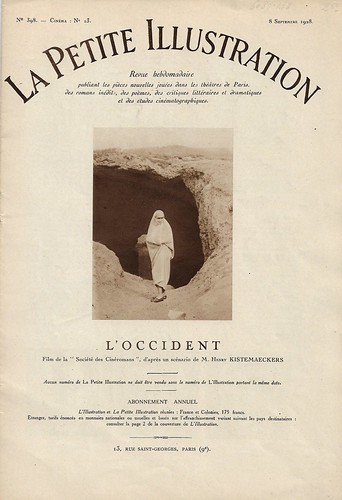
French journal La Petite Illustration no. 398, 8 September 1928. Special issue on the French silent film L'Occident (Henri Fescourt, 1927-28).
Sources: Richard Abel (French Cinema: The First Wave, 1915-1929), Fondation Jerome Seydoux, (French), Wikipedia (French) and IMDb.

French postcard by Europe. Photo: publicity still of L'Occident (Henri Fescourt, 1928). The card makes publicity for the film's premiere screening at the Paris cinema Marivaux. Caption from La Petite Illustration, 398, 1928: "Hassina joins Taïeb into a deserted room."

French postcard by Europe. Photo: publicity still of L'Occident (Henri Fescourt, 1928). The card makes publicity for the film's premiere screening at the Paris cinema Marivaux. Caption: La fuite des pillards (The Escape of the Looters). The left side of the card was printed out of focus.
Exotic melodrama
In L'Occident/The West (Henri Fescourt, 1928), a French squadron before the coast of Morocco tries to prevent rebel gangs from attacking the caravans but is afraid to kill loyal citizens by bombing. So Captain Jean Cadière (Lucien Dalsace), who knows the local language and customs, is sent on a secret mission. He also substitutes for his young protégé, lieutenant Arnaud de Saint-Guil ( Jaque Catelain ).
The next morning, Hassina (Claudia Victrix), a captive of the tribe of Zerreth-Hama, finds Cadière at a well, bitten by a snake. Because of an old prediction, she believes he is her chosen one, so she saves him by sucking out his poison, considers him her master, and brings his papers to the French vessel. Arnaud is impressed by the mysterious woman.
The tribe leader, Taïeb (Hugues de Bagratide), discovers his stallion has been used and female traces are found, but only Hassina's little sister Fathima (Andrée Rolane) is discovered. When Taïeb threatens to burn Fathima if Hassina and Cadière don't come out, and his men attack the couple, the marine starts to fire its guns. The tribe flees, but Taïeb manages to kidnap Fathima. The wounded Hassina is taken away, while the French soldiers lift their guns in homage. Hassina is taken to Toulon, deplores the loss of her sister and understands her lover is a roumi, a French soldier.
Cadière takes Hassani to the vast villa of his aunt Aline (Jane Méa), who adopts her, learns her French and music, but Hassani remains quiet and unhappy. She has gotten a note that the roumi killed her sister, so she is torn between her family and her new lover. Instead, Fathima is not dead but also in Toulon, forced by Taïeb to dance every night in a den. When one night he treats her brutally, sailors, among whom Le Goff, an aid of Cadière, defend her.
Meanwhile, Arnaud is troubled, not only because he is fed up with the army, but also because he is passionately in love with Hassina and hates Cadière. At the betrothal party of Cadière and Hassani, Taïeb appears in disguise and pushes Hassani to avenge her sister, but her love is bigger than her desire for revenge. Arnaud leaves the army. Cadière's aid Le Goff finds Fathima and Taïeb, and after a struggle, the Moroccan confesses his crimes. Cadière himself prevents Arnaud of abducting Hassani and appeals to his conscience, so the latter returns to the army and abstains from committing a crime. Cadière also renders Hassani her sister, so that all ends well.
This exotic melodrama was based on a play by Henri Kistemaeckers, who also scripted the film. The film was produced by Société des Cinéromans, and distributed by Pathé Consortium Cinéma. Sets were by Robert Gys. L'Occident/The West was filmed in 1927, but premiered in France on 26 September 1928 at the Paris cinema Marivaux. The postcards in this post all make publicity for the film's premiere screening at the Marivaux.

French postcard by Europe. Photo: publicity still of L'Occident (Henri Fescourt, 1928). Caption from La Petite Illustration, 398, 1928: "Taïeb forces young Fathima to dance in a den in Toulon."
Tout Paris
The French magazine Cinémagazine wrote about the first night: "It was a great first. Marivaux welcomed Tout-Paris in a brand new auditorium, with new painting and armchairs. They presented L'Occident/The West.
This film, the first part of which was set in Morocco, had to be Moroccan, it was not only by its images, but also by the Nuba and the trumpets of the 6th and the 24th regiment of Spahis who, on the stage, let us hear the most ardent marches of their vibrant repertoire, which thrilled all those who were cavaliers of spahis ... even when, like me, they became territorial.
In the armchairs, on the balcony, in the boxes, Tout-Paris: artists, people of the world, journalists and writers - shimmering toilets, tuxedos or black clothes.
Mr. Painlevé, Minister of War, and General Carence seemed to encourage all the directors of the West to show our soldiers the 'wheat' in action while in his chair, Mr. Steeg, resident general of France in Morocco, talked about the fruits of the efforts by Drude, Amade, and Lyautey.
General Decoin, commanding the division of Spahis at Compiegne, could not find any criticism for the charge of spahis carried on the screen, while Charles Pathé, in the box of M. Sapene, applauded the Provence in action. In short, a beautiful auditorium, a chic room - a room of a grand first night."

French postcard by Europe. Photo: publicity still of L'Occident (Henri Fescourt, 1928). The card makes publicity for the film's premiere screening at the Paris cinema Marivaux. Caption from La Petite Illustration, 398, 1928: "The hour of prayer of the tribe of Zerrath-Hama."
Fading on words of forgiveness and sweetness
On the film itself, Cinémagazine wrote: "Mr. Henry Kistemaeckers has somewhat modified the script of his play, 'The West', created by Suzanne Desprez, which was already shot by Capellani with Nazimova . (...) The film ends with a wedding or an American kiss, which could have been frankly ridiculous, but the last image fades on words of forgiveness and sweetness, heavy with fatality and love, a prelude to other words (...)
Claudia Victrix played Hassina. A heavy task to be true. This artist, rich in intelligent sensitivity, succeeded in conveying the conflict of the Moroccan primitive torn between her love for the roumi, her conqueror, and the atavism of her race. Towards her, Jaque Catelain , a young lieutenant, proves to be tender, while Lucien Dalsace plays a bitter, violent officer, fearless, and without reproach.
H. de Bagratide, a past master in the art of make-up, deserves a special mention for his composition of the role of Taïeb. Paul Guidé, was able to command the battleship Provence with authority and Renée Veller, one of the winners of the last contest of Cinémagazine, as a painful fiancee shows us an upset face - which is beautiful.
The little Andrée Rolane, already so appreciated, embodies gracefully the character of Fathima, the young sister of Hassina. Let's also quote Mrs. Jeanne Méa, Mrs. Liévin, Terrore, Labry, Raymond Guérin. But among the performers of the film, it would be unfair not to mention our sailors, our spahis, the Senegalese riflemen, and the men of the foreign legion who, in an admirably settled fight, jostled Taieb's looters.
The staging is by Henri Fescourt, a master to whom we owe Les Miserables. It deserves to be praised. The fight, as we have said, is admirable of truth, but the director also knew how to use the constructions of the fleet, their guns pointing in the sky, of their life finally to make intensely a work where those of the hinterland play such a beautiful role. Finally, in the first part, there are Moroccan landscapes that recall the most beautiful shots of Les Miserables." (Cinémagazine N° 40, 5 October 1928).

French postcard by Europe, no. 62. Photo: publicity still of L'Occident (Henri Fescourt, 1928). Caption from La Petite Illustration, 398, 1928: "The caïd Taïeb has decided to burn alive young Fathima."
Colonial, stereotypical and Western ideology
But how do modern critics react to L'Occident? In his book 'French Cinema: The First Wave, 1915-1929', Richard Abel was quite critical about the colonial, stereotypical and Western ideology of the film, in which one of the questions is whether an Oriental woman can become a Western woman, while the lead is played by a Western actress (and Abel wasn't convinced of Victrix' play).
Years after, director Fescourt himself recognised that none of the directors of the climactic battle scene - filmed in "the best western style" as Abel writes - asked themselves at the time whether the local extras playing the retreating Moroccan crowds might have been unhappy with their roles.
Abel situates L'Occident within the wave of French Orientalist films after the success of L'Atlantide (Jacques Feyder, 1921), with such examples as Visages voilés... âmes closes/The Sheik's Wife (Henry Roussel, 1921), Le Sang d'Allah/The Blood of Allah (Luitz-Morat, Alfred Vercourt, 1922), Sables/Sands (Dimitri Kirsanoff, 1927), and Maman Colibri/Mother Hummingbird (Julien Duvivier, 1929).
He also notes that it is remarkable that - possibly led by the negative public reactions to the war - French silent filmmakers hardly treated the war between the French foreign legion and the Moroccans, ending with the surrender of the Riftians in 1926.

French journal La Petite Illustration no. 398, 8 September 1928. Special issue on the French silent film L'Occident (Henri Fescourt, 1927-28).
Sources: Richard Abel (French Cinema: The First Wave, 1915-1929), Fondation Jerome Seydoux, (French), Wikipedia (French) and IMDb.
Published on August 26, 2019 22:00
August 25, 2019
New acquisitions at G.D.I.: a gift from Kathinka Dittrich, Part 2
Yesterday, EFSP posted on an old postcard album which Egbert Barten of the Geoffrey Donaldson Institute (G.D.I.) received from German film historian and author Kathinka Dittrich. The album contains dozens of German and Dutch postcards which were collected by a Dutch girl around 1930. The album includes several hand coloured film star postcards by Ross Verlag and one by Iris-Verlag which we had never seen before. Today, we share a selection with you.
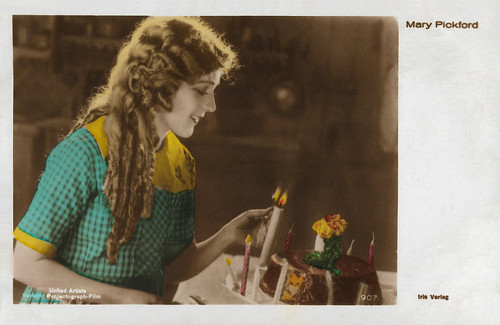
Austrian postcard by Iris-Verlag, no. 907. Photo: United Artists / Projectograph-Film. Mary Pickford in Little Annie Rooney (William Beaudine, 1925). Collection: Geoffrey Donaldson Institute.
Mary Pickford (1892-1972) was a legendary silent film actress and was known as 'America’s sweetheart.' She was a founder of United Artists and helped establish the Academy.
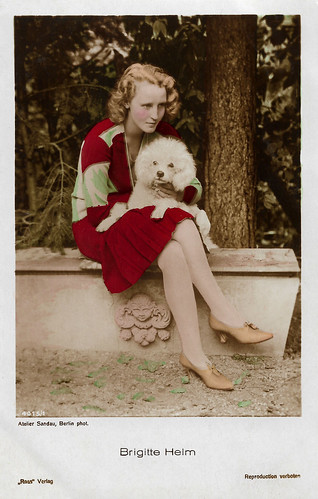
German postcard by Ross Verlag, no. 4015/1, 1929-1930. Photo: Atelier Sandau, Berlin. Collection: Geoffrey Donaldson Institute.
German actress Brigitte Helm (1908-1996) is still famous for her dual role as Maria and her double the evil Maria, the 'Maschinenmensch', in the silent SF classic Metropolis (Fritz Lang, 1927). After Metropolis she made a string of over 30 films in which she almost always had the starring role. She easily made the transition to sound films, before she abruptly retired in 1935.
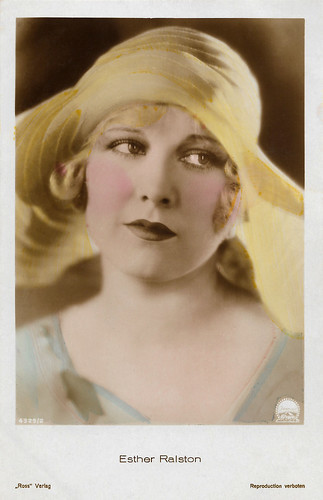
German postcard by Ross Verlag, no. 4329/2, 1929-1930. Photo: Paramount. Esther Ralston in The Wheel of Life (Victor Schertzinger, 1929). Collection: Geoffrey Donaldson Institute.
Projected as wholesome but fun-loving, Maine-born leading lady Esther Ralston (1902-1994) enjoyed a prime silent age career. She appeared in close to 100 films over a nearly 30-year period. At her peak, she was packaged and publicised as 'The American Venus' by Florenz Ziegfeld Jr. after appearing as a dazzling beauty queen in the film The American Venus (1926). A decade later, the blonde beauty's career, however, had tapered off.
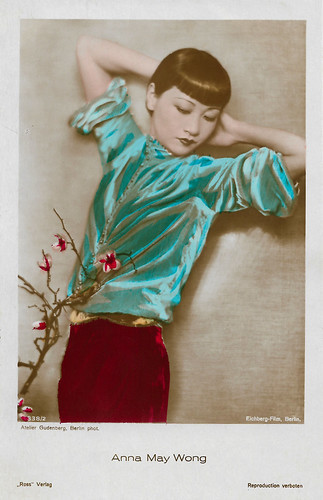
German postcard by Ross Verlag, Berlin, no. 4338/2, 1929-1930. Photo: Atelier Gudenberg, Berlin / Eichberg-Film, Berlin. Collection: Geoffrey Donaldson Institute.
Anna May Wong (1905-1961) was the first Chinese American movie star, and the first Asian American actress to gain international recognition. Frustrated by the stereotypical supporting roles she reluctantly played in Hollywood, Wong left for Europe, where she starred in such classics as Piccadilly (1929).
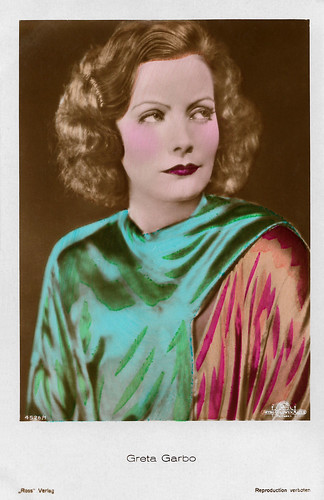
German postcard by Ross Verlag, no. 4526/1, 1929-1930. Collection: Geoffrey Donaldson Institute.
Swedish Greta Garbo (1905-1990) is often regarded as one of the greatest and most glamorous movie stars ever produced by the Hollywood studio system. She was part of the Golden Age of the silent film of the 1920s and was one of the few actors who made a glorious transition to the talkies. She started her career in the European cinema and would always stay more popular in Europe than in the USA.
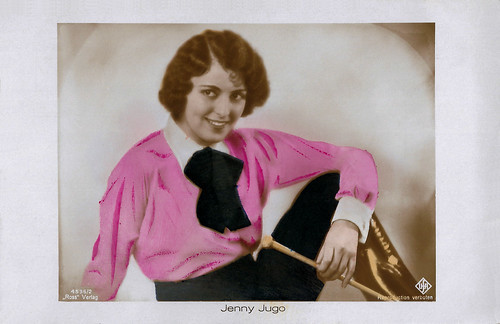
German postcard by Ross Verlag, no. 4536/2, 1929-1930. Photo: Ufa. Collection: Geoffrey Donaldson Institute.
Pretty Austrian actress Jenny Jugo (1904-2001) had a prolific career in German cinema, from the late silent era well into the war years. She did particularly well as comedienne and starred between 1931 and 1942 in eleven smart and charming comedies directed by Erich Engel.
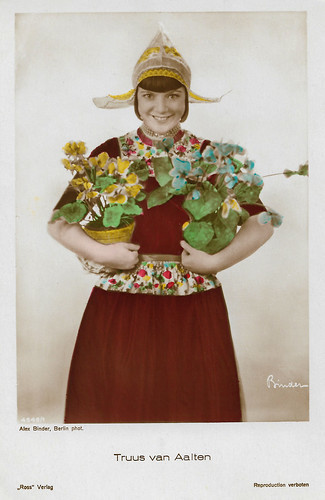
German postcard by Ross Verlag, Berlin, no. 4549/1, 1929-1930. Photo: Alex Binder, Berlin. Collection: Geoffrey Donaldson Institute.
Dutch film star Truus van Aalten (1910-1999) made 29 films in the 1920s and 1930s, and only one of them in the Netherlands.
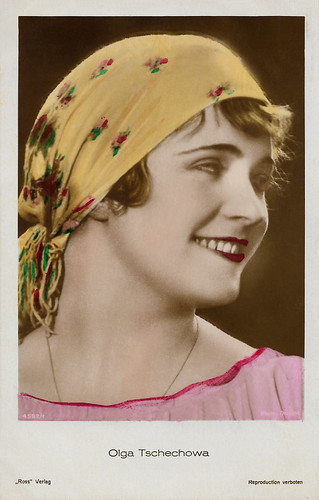
German postcard by Ross-Verlag, Berlin, no. 4592/1, 1929-1930. Photo: Defina. Collection: Geoffrey Donaldson Institute.
Dignified German-Russian actress Olga Tschechova (1897-1980) was one of the most popular stars of the silent film era. She remained a mysterious person throughout her life.
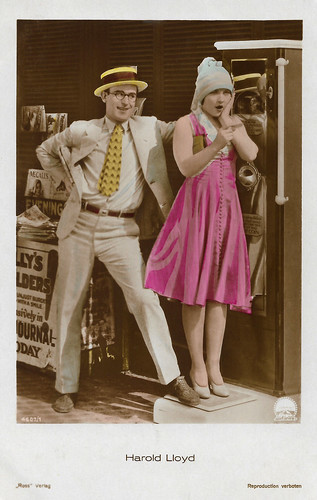
German postcard by Ross Verlag, no. 4607/1, 1929-1930. Photo: Paramount. Harold Lloyd and Ann Christy in Speedy (Ted Wilde, 1928). Collection: Geoffrey Donaldson Institute.
American actor, comedian, director, producer, screenwriter, and stunt performer Harold Lloyd (1893-1971) is best known for his silent comedies. He ranks alongside Charlie Chaplin and Buster Keaton as one of the three most popular and influential comedians of the silent film. Between 1914 and 1947, Lloyd made nearly 200 comedies, often as a bespectacled 'Glass' character, a resourceful, success-seeking go-getter who was perfectly in tune with 1920s-era United States. His films frequently contained 'thrill sequences' of extended chase scenes and daredevil physical feats. A classic is Lloyd hanging from the hands of a clock high above the street in Safety Last! (1923).
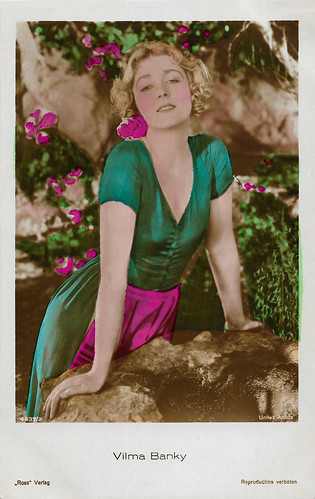
German postcard by Ross Verlag, no. 4637/2, 1929-1930. Photo: United Artists. Vilma Banky in The Awakening (Victor Fleming, 1929). Collection: Geoffrey Donaldson Institute.
Hungarian-born silent film star Vilma Bánky (1898-1991) filmed in Budapest, France, Austria, and Germany, before Sam Goldwyn took her to Hollywood. There she starred opposite great silent stars like Rudolph Valentino and Ronald Colman. She became Goldwyn's biggest money maker till sound finished her career.
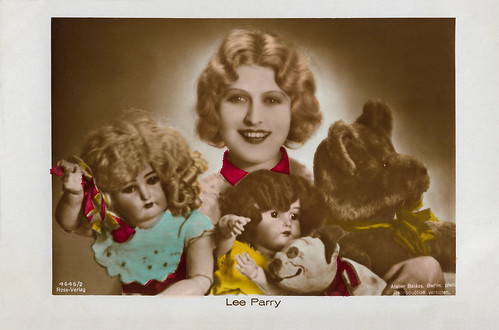
German postcard by Ross Verlag, no. 4646/2, 1929-1930. Photo: Atelier Balàzs, Berlin. Collection: Geoffrey Donaldson Institute.
Lee Parry (1901-1977) was a German film actress of the silent and the early sound era, often in films by her husband Richard Eichberg. She appeared in 48 films between 1919 and 1939.

German postcard by Ross-Verlag, no. 4672/3, 1928-1929. Photo: Paramount. Collection: Geoffrey Donaldson Institute.
American actress Clara Bow (1905-1965) rose to stardom in silent film during the 1920s. It was her appearance as a plucky shopgirl in the film It (Clarence G. Badger, 1927) that brought her global fame and the nickname 'The It Girl'. Bow came to personify the Roaring Twenties and is described as its leading sex symbol.
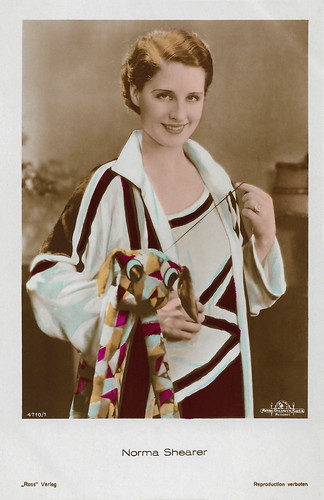
German postcard by Ross Verlag, no. 4710/1, 1929-1930. Photo: Metro-Goldwyn-Mayer. Collection: Geoffrey Donaldson Institute.
American actress Norma Shearer (1902-1983) was the 'First Lady of MGM'.
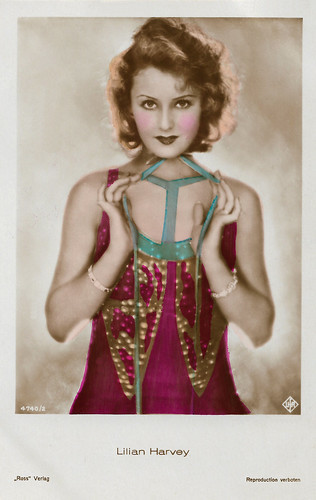
German postcard by Ross Verlag, no. 4740/2, 1929-1930. Photo: Ufa. Collection: Geoffrey Donaldson Institute.
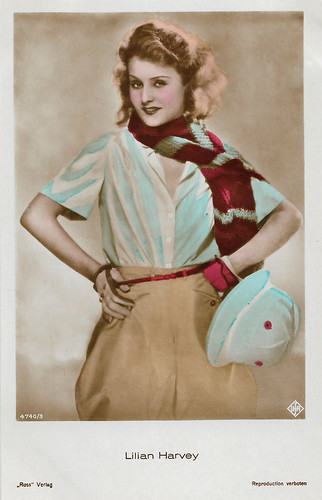
German postcard by Ross Verlag, no. 4740/3, 1929-1930. Photo: Ufa. Collection: Geoffrey Donaldson Institute.
British born, German actress and singer Lilian Harvey (1906-1968) was Ufa's biggest star of the 1930s. With Willy Fritsch she formed the 'Dream Team of the European Cinema'. Their best film was the immensely popular film operetta Der Kongress tanzt/The Congress Dances (Erik Charell, 1931).
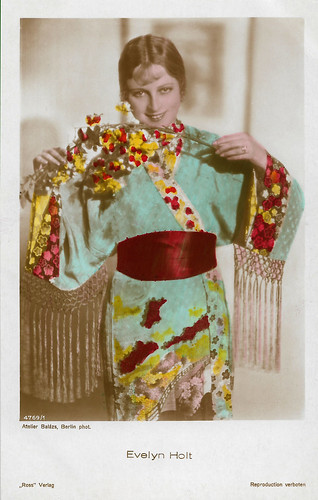
German postcard by Ross Verlag, no. 4769/1, 1929-1930. Photo: Atelier Balázs, Berlin. Collection: Geoffrey Donaldson Institute.
Evelyn Holt (1908-2001) was a highly popular German film actress in the late silent and the early sound era. The rise of the Nazis finished her blossoming film career.
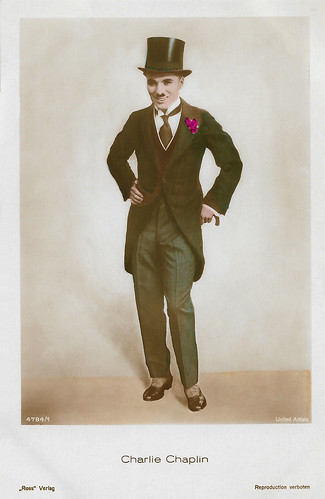
German postcard by Ross Verlag, no. 4784/1, 1929-1930. Photo: United Artists. Collection: Geoffrey Donaldson Institute.
English comedian Charles ‘Charlie’ Chaplin (1889-1977) was one of the most creative and influential personalities of the silent-film era. His most famous role was that of The Tramp with his toothbrush moustache, undersized bowler hat and bamboo cane who struggled to survive while keeping his dignity in a world with great social injustice. Chaplin used mime, slapstick and other visual comedy routines, and he not only starred in his films, but also directed, wrote and produced them, and composed the music as well.

German postcard by Ross Verlag, no. 4813/2, 1929-1930. Photo: Radio Pictures Collection: Geoffrey Donaldson Institute.
American film actor Tom Mix (1880–1940) was the star of many early Westerns between 1909 and 1935. Mix appeared in 291 films, all but nine of which were silent movies. He was Hollywood's first Western megastar and helped to define the genre for all cowboy actors who followed.
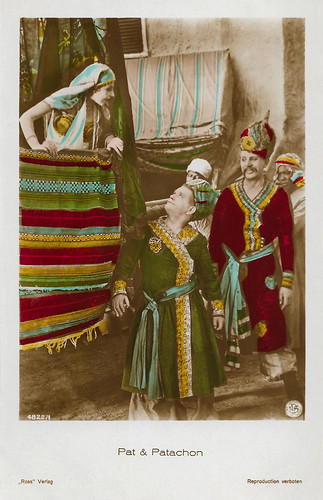
German postcard by Ross Verlag, no. 4822/1, 1929-1930. Photo: Deutsche Lichtspiel-Syndikat (DLS). Fy og Bi in Alf's Carpet/The Rocket Bus (W.P. Kellino, 1929). Collection: Geoffrey Donaldson Institute.
The Danish double-act Fy og Bi (Fyrtårnet og Bivognen a.k.a. Pat & Patachon) was the most famous comedy couple of the European silent cinema. Long Carl Schenstrom (1881-1942) and short Harald Madsen (1890-1949) became very popular in the 1920s with their short slapstick films.
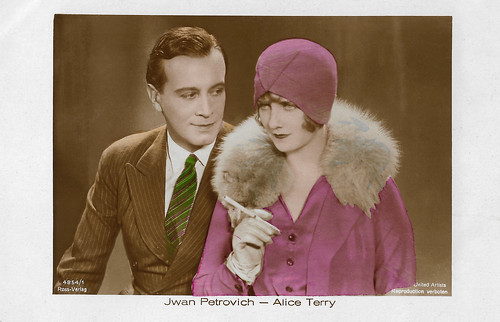
German postcard by Ross Verlag, no. 4854/1, 1929-1930. Photo: United Artists. Ivan Petrovich and Alice Terry in The Three Passions (Rex Ingram, 1928). Collection: Geoffrey Donaldson Institute.
Hungarian actor Iván Petrovich (1894-1962) started his career with silent Hungarian films and appeared till his death in nearly 100 European films.
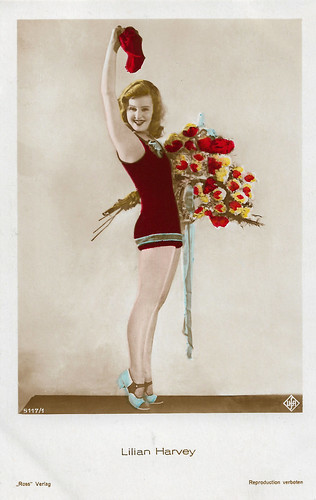
German postcard by Ross Verlag, no. 5117/1, 1930-1931. Photo: Ufa. Collection: Geoffrey Donaldson Institute.
British born, German actress and singer Lilian Harvey (1906-1968) was Ufa's biggest star of the 1930s. With Willy Fritsch she formed the 'Dream Team of the European Cinema'. Their best film was the immensely popular film operetta Der Kongress tanzt/The Congress Dances (Erik Charell, 1931).
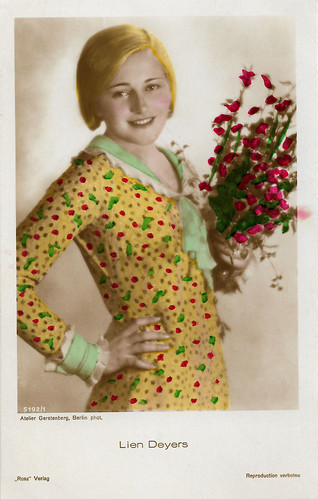
German postcard by Ross Verlag, no. 5192/1, 1930-1931. Photo: Atelier Gerstenberg, Berlin. Collection: Geoffrey Donaldson Institute.
Dutch actress Lien Deyers (1910-1965) - also known as Lien Deijers and Lien Dyers - was discovered by famous director Fritz Lang who gave her a part in Spione/Spies (1928). She acted in a stream of late silent and early sound films. After 1935 her star faded rapidly and her life ended in tragedy.
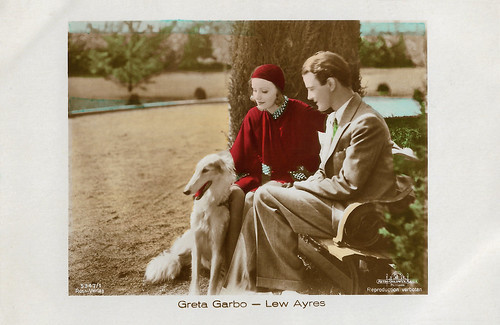
German postcard by Ross Verlag, no. 5347/1, 1930-1931. Photo: Metro-Goldwyn- Mayer. Greta Garbo and Lew Ayres in The Kiss (Jacques Feyder, 1929). Collection: Geoffrey Donaldson Institute.
Swedish Greta Garbo (1905-1990) is often regarded as one of the greatest and most glamorous movie stars ever produced by the Hollywood studio system. She was part of the Golden Age of the silent film of the 1920s and was one of the few actors who made a glorious transition to the talkies. She started her career in the European cinema and would always stay more popular in Europe than in the USA.
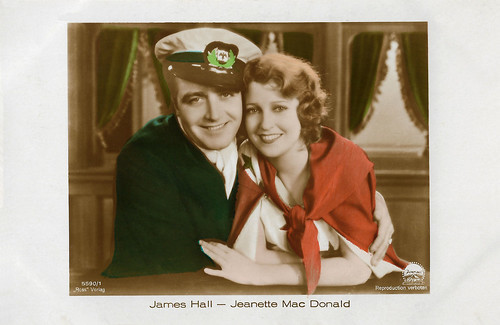
German postcard by Ross Verlag, no. 5590/1, 1930-1931. Photo: Paramount. James Hall and Jeanette MacDonald in Let's Go Native (Leo McCarey, 1930). Collection: Geoffrey Donaldson Institute.
Red-headed and blue-green eyed operatic singer Jeanette MacDonald (1903-1965) was discovered for the cinema by Ernst Lubitsch, who cast her opposite Maurice Chevalier in The Love Parade (1929). Later 'the Iron Butterfly' co-starred with Nelson Eddy in a string of successful musicals and played opposite Clark Gable in San Francisco (1936).
EFSP thanks Egbert Barten, Kathinka Dittrich and the late Mrs. Rietje Smith-Van Eekeren.

Austrian postcard by Iris-Verlag, no. 907. Photo: United Artists / Projectograph-Film. Mary Pickford in Little Annie Rooney (William Beaudine, 1925). Collection: Geoffrey Donaldson Institute.
Mary Pickford (1892-1972) was a legendary silent film actress and was known as 'America’s sweetheart.' She was a founder of United Artists and helped establish the Academy.

German postcard by Ross Verlag, no. 4015/1, 1929-1930. Photo: Atelier Sandau, Berlin. Collection: Geoffrey Donaldson Institute.
German actress Brigitte Helm (1908-1996) is still famous for her dual role as Maria and her double the evil Maria, the 'Maschinenmensch', in the silent SF classic Metropolis (Fritz Lang, 1927). After Metropolis she made a string of over 30 films in which she almost always had the starring role. She easily made the transition to sound films, before she abruptly retired in 1935.

German postcard by Ross Verlag, no. 4329/2, 1929-1930. Photo: Paramount. Esther Ralston in The Wheel of Life (Victor Schertzinger, 1929). Collection: Geoffrey Donaldson Institute.
Projected as wholesome but fun-loving, Maine-born leading lady Esther Ralston (1902-1994) enjoyed a prime silent age career. She appeared in close to 100 films over a nearly 30-year period. At her peak, she was packaged and publicised as 'The American Venus' by Florenz Ziegfeld Jr. after appearing as a dazzling beauty queen in the film The American Venus (1926). A decade later, the blonde beauty's career, however, had tapered off.

German postcard by Ross Verlag, Berlin, no. 4338/2, 1929-1930. Photo: Atelier Gudenberg, Berlin / Eichberg-Film, Berlin. Collection: Geoffrey Donaldson Institute.
Anna May Wong (1905-1961) was the first Chinese American movie star, and the first Asian American actress to gain international recognition. Frustrated by the stereotypical supporting roles she reluctantly played in Hollywood, Wong left for Europe, where she starred in such classics as Piccadilly (1929).

German postcard by Ross Verlag, no. 4526/1, 1929-1930. Collection: Geoffrey Donaldson Institute.
Swedish Greta Garbo (1905-1990) is often regarded as one of the greatest and most glamorous movie stars ever produced by the Hollywood studio system. She was part of the Golden Age of the silent film of the 1920s and was one of the few actors who made a glorious transition to the talkies. She started her career in the European cinema and would always stay more popular in Europe than in the USA.

German postcard by Ross Verlag, no. 4536/2, 1929-1930. Photo: Ufa. Collection: Geoffrey Donaldson Institute.
Pretty Austrian actress Jenny Jugo (1904-2001) had a prolific career in German cinema, from the late silent era well into the war years. She did particularly well as comedienne and starred between 1931 and 1942 in eleven smart and charming comedies directed by Erich Engel.

German postcard by Ross Verlag, Berlin, no. 4549/1, 1929-1930. Photo: Alex Binder, Berlin. Collection: Geoffrey Donaldson Institute.
Dutch film star Truus van Aalten (1910-1999) made 29 films in the 1920s and 1930s, and only one of them in the Netherlands.

German postcard by Ross-Verlag, Berlin, no. 4592/1, 1929-1930. Photo: Defina. Collection: Geoffrey Donaldson Institute.
Dignified German-Russian actress Olga Tschechova (1897-1980) was one of the most popular stars of the silent film era. She remained a mysterious person throughout her life.

German postcard by Ross Verlag, no. 4607/1, 1929-1930. Photo: Paramount. Harold Lloyd and Ann Christy in Speedy (Ted Wilde, 1928). Collection: Geoffrey Donaldson Institute.
American actor, comedian, director, producer, screenwriter, and stunt performer Harold Lloyd (1893-1971) is best known for his silent comedies. He ranks alongside Charlie Chaplin and Buster Keaton as one of the three most popular and influential comedians of the silent film. Between 1914 and 1947, Lloyd made nearly 200 comedies, often as a bespectacled 'Glass' character, a resourceful, success-seeking go-getter who was perfectly in tune with 1920s-era United States. His films frequently contained 'thrill sequences' of extended chase scenes and daredevil physical feats. A classic is Lloyd hanging from the hands of a clock high above the street in Safety Last! (1923).

German postcard by Ross Verlag, no. 4637/2, 1929-1930. Photo: United Artists. Vilma Banky in The Awakening (Victor Fleming, 1929). Collection: Geoffrey Donaldson Institute.
Hungarian-born silent film star Vilma Bánky (1898-1991) filmed in Budapest, France, Austria, and Germany, before Sam Goldwyn took her to Hollywood. There she starred opposite great silent stars like Rudolph Valentino and Ronald Colman. She became Goldwyn's biggest money maker till sound finished her career.

German postcard by Ross Verlag, no. 4646/2, 1929-1930. Photo: Atelier Balàzs, Berlin. Collection: Geoffrey Donaldson Institute.
Lee Parry (1901-1977) was a German film actress of the silent and the early sound era, often in films by her husband Richard Eichberg. She appeared in 48 films between 1919 and 1939.

German postcard by Ross-Verlag, no. 4672/3, 1928-1929. Photo: Paramount. Collection: Geoffrey Donaldson Institute.
American actress Clara Bow (1905-1965) rose to stardom in silent film during the 1920s. It was her appearance as a plucky shopgirl in the film It (Clarence G. Badger, 1927) that brought her global fame and the nickname 'The It Girl'. Bow came to personify the Roaring Twenties and is described as its leading sex symbol.

German postcard by Ross Verlag, no. 4710/1, 1929-1930. Photo: Metro-Goldwyn-Mayer. Collection: Geoffrey Donaldson Institute.
American actress Norma Shearer (1902-1983) was the 'First Lady of MGM'.

German postcard by Ross Verlag, no. 4740/2, 1929-1930. Photo: Ufa. Collection: Geoffrey Donaldson Institute.

German postcard by Ross Verlag, no. 4740/3, 1929-1930. Photo: Ufa. Collection: Geoffrey Donaldson Institute.
British born, German actress and singer Lilian Harvey (1906-1968) was Ufa's biggest star of the 1930s. With Willy Fritsch she formed the 'Dream Team of the European Cinema'. Their best film was the immensely popular film operetta Der Kongress tanzt/The Congress Dances (Erik Charell, 1931).

German postcard by Ross Verlag, no. 4769/1, 1929-1930. Photo: Atelier Balázs, Berlin. Collection: Geoffrey Donaldson Institute.
Evelyn Holt (1908-2001) was a highly popular German film actress in the late silent and the early sound era. The rise of the Nazis finished her blossoming film career.

German postcard by Ross Verlag, no. 4784/1, 1929-1930. Photo: United Artists. Collection: Geoffrey Donaldson Institute.
English comedian Charles ‘Charlie’ Chaplin (1889-1977) was one of the most creative and influential personalities of the silent-film era. His most famous role was that of The Tramp with his toothbrush moustache, undersized bowler hat and bamboo cane who struggled to survive while keeping his dignity in a world with great social injustice. Chaplin used mime, slapstick and other visual comedy routines, and he not only starred in his films, but also directed, wrote and produced them, and composed the music as well.

German postcard by Ross Verlag, no. 4813/2, 1929-1930. Photo: Radio Pictures Collection: Geoffrey Donaldson Institute.
American film actor Tom Mix (1880–1940) was the star of many early Westerns between 1909 and 1935. Mix appeared in 291 films, all but nine of which were silent movies. He was Hollywood's first Western megastar and helped to define the genre for all cowboy actors who followed.

German postcard by Ross Verlag, no. 4822/1, 1929-1930. Photo: Deutsche Lichtspiel-Syndikat (DLS). Fy og Bi in Alf's Carpet/The Rocket Bus (W.P. Kellino, 1929). Collection: Geoffrey Donaldson Institute.
The Danish double-act Fy og Bi (Fyrtårnet og Bivognen a.k.a. Pat & Patachon) was the most famous comedy couple of the European silent cinema. Long Carl Schenstrom (1881-1942) and short Harald Madsen (1890-1949) became very popular in the 1920s with their short slapstick films.

German postcard by Ross Verlag, no. 4854/1, 1929-1930. Photo: United Artists. Ivan Petrovich and Alice Terry in The Three Passions (Rex Ingram, 1928). Collection: Geoffrey Donaldson Institute.
Hungarian actor Iván Petrovich (1894-1962) started his career with silent Hungarian films and appeared till his death in nearly 100 European films.

German postcard by Ross Verlag, no. 5117/1, 1930-1931. Photo: Ufa. Collection: Geoffrey Donaldson Institute.
British born, German actress and singer Lilian Harvey (1906-1968) was Ufa's biggest star of the 1930s. With Willy Fritsch she formed the 'Dream Team of the European Cinema'. Their best film was the immensely popular film operetta Der Kongress tanzt/The Congress Dances (Erik Charell, 1931).

German postcard by Ross Verlag, no. 5192/1, 1930-1931. Photo: Atelier Gerstenberg, Berlin. Collection: Geoffrey Donaldson Institute.
Dutch actress Lien Deyers (1910-1965) - also known as Lien Deijers and Lien Dyers - was discovered by famous director Fritz Lang who gave her a part in Spione/Spies (1928). She acted in a stream of late silent and early sound films. After 1935 her star faded rapidly and her life ended in tragedy.

German postcard by Ross Verlag, no. 5347/1, 1930-1931. Photo: Metro-Goldwyn- Mayer. Greta Garbo and Lew Ayres in The Kiss (Jacques Feyder, 1929). Collection: Geoffrey Donaldson Institute.
Swedish Greta Garbo (1905-1990) is often regarded as one of the greatest and most glamorous movie stars ever produced by the Hollywood studio system. She was part of the Golden Age of the silent film of the 1920s and was one of the few actors who made a glorious transition to the talkies. She started her career in the European cinema and would always stay more popular in Europe than in the USA.

German postcard by Ross Verlag, no. 5590/1, 1930-1931. Photo: Paramount. James Hall and Jeanette MacDonald in Let's Go Native (Leo McCarey, 1930). Collection: Geoffrey Donaldson Institute.
Red-headed and blue-green eyed operatic singer Jeanette MacDonald (1903-1965) was discovered for the cinema by Ernst Lubitsch, who cast her opposite Maurice Chevalier in The Love Parade (1929). Later 'the Iron Butterfly' co-starred with Nelson Eddy in a string of successful musicals and played opposite Clark Gable in San Francisco (1936).
EFSP thanks Egbert Barten, Kathinka Dittrich and the late Mrs. Rietje Smith-Van Eekeren.
Published on August 25, 2019 22:00
August 24, 2019
New acquisitions at G.D.I.: a gift from Kathinka Dittrich, Part 1
Yesterday, EFSP had a post on a collection of postcards which Egbert Barten of the Geoffrey Donaldson Institute (G.D.I.) recently acquired. G.D.I. also received another, much older album from German film historian and author Kathinka Dittrich. Between 1981 and 1986, she was director of the Goethe Institute in Amsterdam and gained fame through the 'Berlin-Amsterdam 1920-1940 - Interactions' project. In 1987, she became a doctor of letters at the University of Amsterdam with her dissertation 'Achter het Doek' (Behind the Screen), about German emigrants in the Dutch cinema during the 1930s. Around that time, a lady from Amsterdam gave her this album. In the album, a little card reveals the name of the original owner, Mrs. Rietje Smith-Van Eekeren. The album contains film star postcards which the young Rietje probably collected around 1930, and it contains several hand-coloured and quite rare cards. For today's post we did a selection of the black and white and sepia postcards. Tomorrow follows a post with the hand-coloured cards.
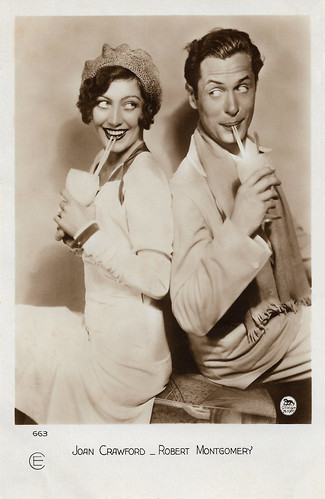
French postcard by Cinémagazine-Edition, Paris, no. 663. Photo: Metro-Goldwyn-Mayer. Joan Crawford and Robert Montgomery in Untamed (Jack Conway, 1929). Collection: Geoffrey Donaldson Institute.
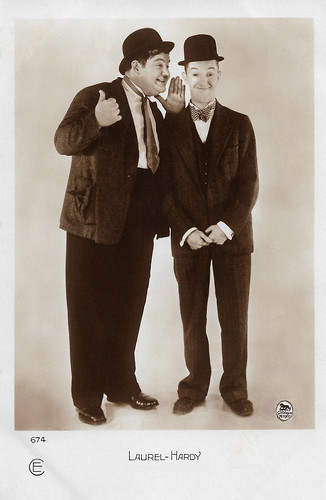
Stan Laurel and Oliver Hardy . French postcard by Cinémagazine-Edition, Paris, no. 674. Photo: Goldwyn Mayer (MGM). Collection: Geoffrey Donaldson Institute.
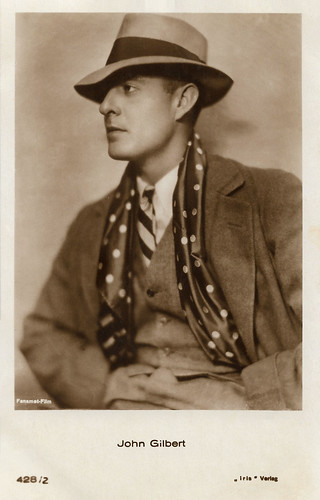
John Gilbert . Austrian postcard by Iris Verlag, no. 428/2. Photo: Metro-Goldwyn Pictures. Collection: Geoffrey Donaldson Institute.
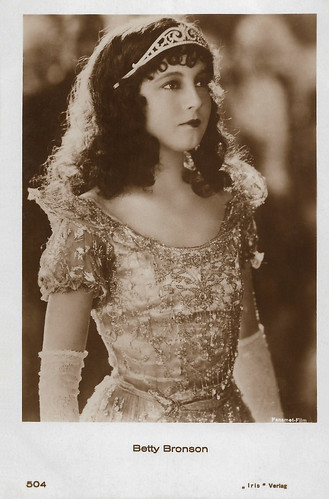
Austrian postcard by Iris-Verlag, no. 504. Photo: Fanamet-Film. Betty Bronson in A Kiss for Cinderella (Herbert Brenon, 1925). Collection: Geoffrey Donaldson Institute.
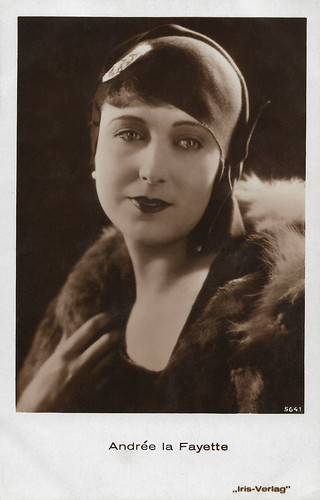
Andrée Lafayette. Austrian postcard by Iris Verlag, no. 5641. Collection: Geoffrey Donaldson Institute.
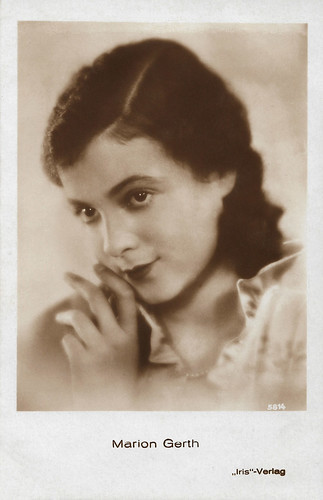
Marion Gerth. Austrian postcard by Iris Verlag, no. 5814. Collection: Geoffrey Donaldson Institute.
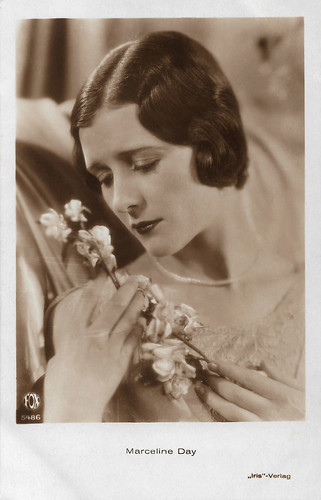
Marceline Day. Austrian postcard by Iris Verlag, no. 5486. Photo: Fox. Collection: Geoffrey Donaldson Institute.
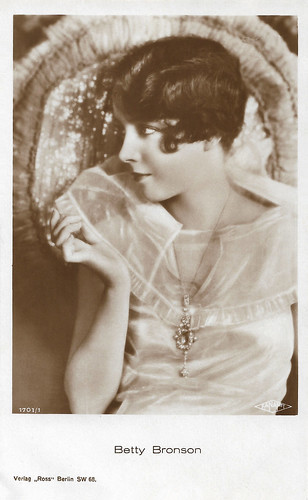
Betty Bronson. German postcard by Ross Verlag, no. 1701/1, 1927-1928. Photo: Fanamet. Collection: Geoffrey Donaldson Institute.

Pat & Patachon (Fy og Bi). German postcard by Ross Verlag, no. 4453/2, 1929-1930. Photo: Lothar Stark-Film. Collection: Geoffrey Donaldson Institute.
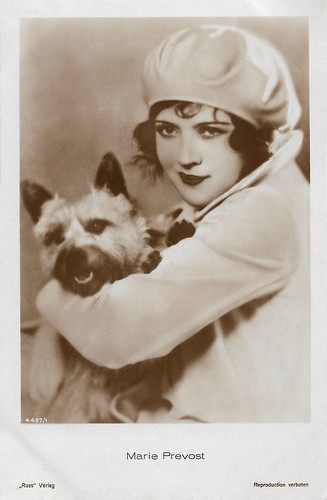
Marie Prevost . German postcard by Ross Verlag, no. 4467/1, 1929-1930. Collection: Geoffrey Donaldson Institute.
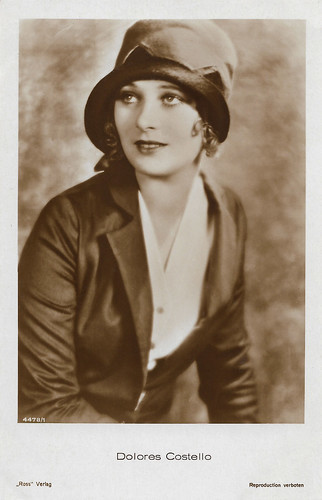
Dolores Costello. German postcard by Ross Verlag, no. 4478/1, 1929-1930. Collection: Geoffrey Donaldson Institute.
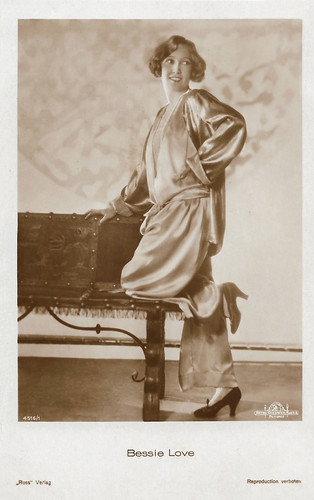
Bessie Love. German postcard by Ross Verlag, no. 4516/1, 1929-1930. Photo: Metro-Goldwyn-Mayer. Collection: Geoffrey Donaldson Institute.
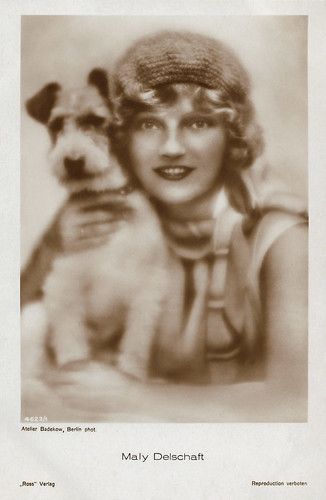
Maly Delschaft . German postcard by Ross Verlag, no. 4623/1, 1929-1930. Photo: Atelier Badekow, Berlin. Collection: Geoffrey Donaldson Institute.
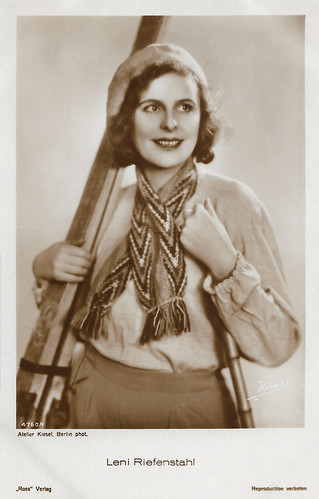
Leni Riefenstahl . German postcard by Ross Verlag, no. 4660/1, 1929-1930. Photo: Atelier Kiesel. Collection: Geoffrey Donaldson Institute.
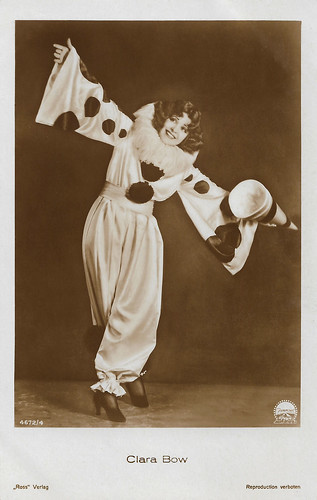
Clara Bow. German postcard by Ross-Verlag, no. 4672/4, 1928-1929. Photo: Paramount.
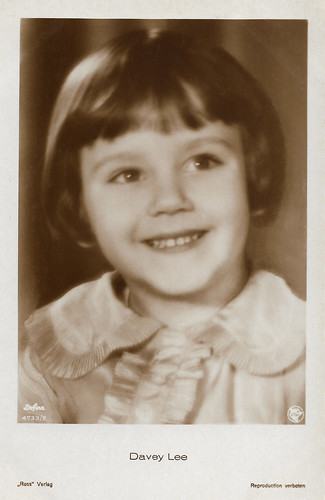
Davey Lee. German postcard by Ross Verlag, no. 4733/2, 1929-1930. Photo: Defina / First National. Collection: Geoffrey Donaldson Institute.
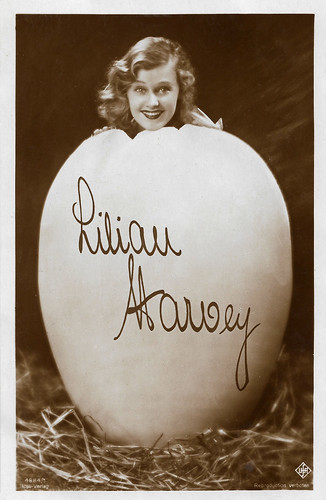
Lilian Harvey . German postcard by Ross Verlag, no. 4884/1, 1929-1930. Photo: Ufa. Collection: Geoffrey Donaldson Institute.
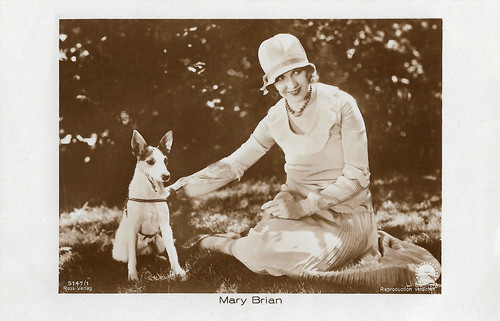
Mary Brian. German postcard by Ross Verlag, no. 5147/1, 1930-1931. Photo: Paramount. Collection: Geoffrey Donaldson Institute.
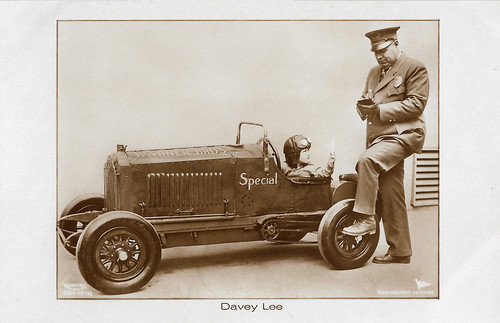
Davey Lee. German postcard by Ross Verlag, no. 5184/1, 1930-1931. Photo: Warner Bros. / National. Collection: Geoffrey Donaldson Institute.
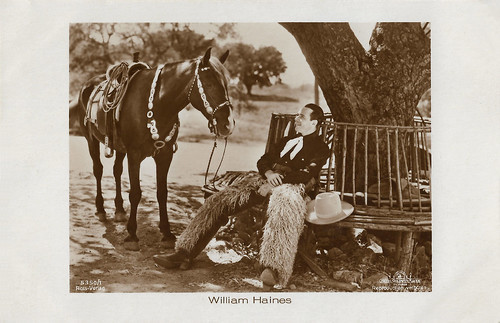
German postcard by Ross Verlag, no. 5350/1, 1930-1931. Photo: Metro-Goldwyn-Mayer. William Haines in Way Out West (Fred Niblo, 1930). Collection: Geoffrey Donaldson Institute.
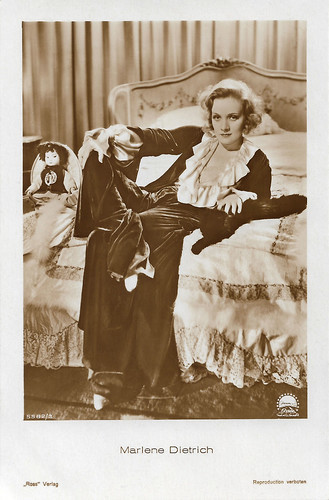
Marlene Dietrich . German postcard by Ross Verlag, no. 5582/3, 1930-1931. Photo: Paramount. Collection: Geoffrey Donaldson Institute.
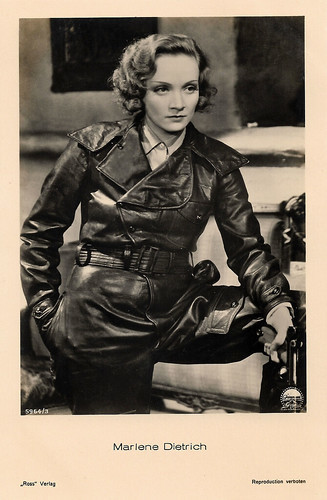
German postcard by Ross Verlag, no. 5964/3, 1930-1931. Photo: Paramount. Marlene Dietrich in Dishonored/Agent X27 (Josef von Sternberg, 1931). Collection: Geoffrey Donaldson Institute.
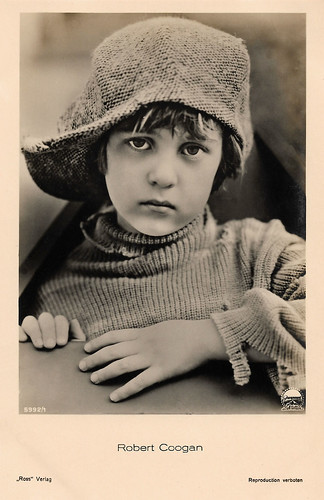
German postcard by Ross Verlag, no. 5992/1, 1930-1931. Photo: Paramount. Robert Coogan in Sooky (Norman Taurog, 1931). Collection: Geoffrey Donaldson Institute.

German postcard by Ross Verlag, no. 6715/1, 1931-1932. Photo: Paramount. Barbara Kent and Harold Lloyd in Feet First (Clyde Bruckman, 1930). Collection: Geoffrey Donaldson Institute.
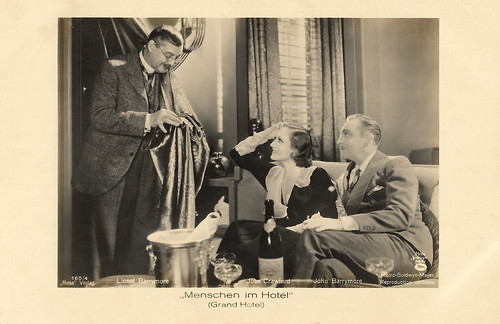
German postcard by Ross Verlag, no. 160/4. Photo: Metro-Goldwyn-Mayer. Lionel Barrymore, Joan Crawford and John Barrymore in Grand Hotel (Edmund Goulding, 1932). Collection: Geoffrey Donaldson Institute.
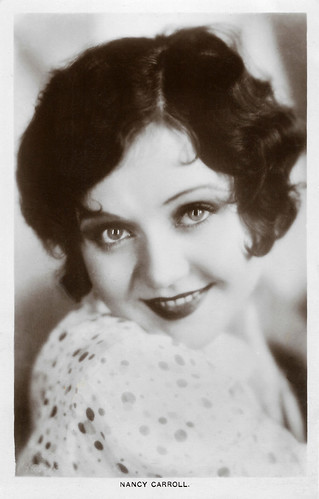
Nancy Carroll . British postcard in the Picturegoer Series, London, no. 400. Sent by mail from The Netherlands to Berlgium in 1930. Collection: Geoffrey Donaldson Institute.
Source: Wikipedia (Dutch). And many thanks to Egbert Barten, Kathinka Dittrich and the late Mrs. Rietje Smith-Van Eekeren.

French postcard by Cinémagazine-Edition, Paris, no. 663. Photo: Metro-Goldwyn-Mayer. Joan Crawford and Robert Montgomery in Untamed (Jack Conway, 1929). Collection: Geoffrey Donaldson Institute.

Stan Laurel and Oliver Hardy . French postcard by Cinémagazine-Edition, Paris, no. 674. Photo: Goldwyn Mayer (MGM). Collection: Geoffrey Donaldson Institute.

John Gilbert . Austrian postcard by Iris Verlag, no. 428/2. Photo: Metro-Goldwyn Pictures. Collection: Geoffrey Donaldson Institute.

Austrian postcard by Iris-Verlag, no. 504. Photo: Fanamet-Film. Betty Bronson in A Kiss for Cinderella (Herbert Brenon, 1925). Collection: Geoffrey Donaldson Institute.

Andrée Lafayette. Austrian postcard by Iris Verlag, no. 5641. Collection: Geoffrey Donaldson Institute.

Marion Gerth. Austrian postcard by Iris Verlag, no. 5814. Collection: Geoffrey Donaldson Institute.

Marceline Day. Austrian postcard by Iris Verlag, no. 5486. Photo: Fox. Collection: Geoffrey Donaldson Institute.

Betty Bronson. German postcard by Ross Verlag, no. 1701/1, 1927-1928. Photo: Fanamet. Collection: Geoffrey Donaldson Institute.

Pat & Patachon (Fy og Bi). German postcard by Ross Verlag, no. 4453/2, 1929-1930. Photo: Lothar Stark-Film. Collection: Geoffrey Donaldson Institute.

Marie Prevost . German postcard by Ross Verlag, no. 4467/1, 1929-1930. Collection: Geoffrey Donaldson Institute.

Dolores Costello. German postcard by Ross Verlag, no. 4478/1, 1929-1930. Collection: Geoffrey Donaldson Institute.

Bessie Love. German postcard by Ross Verlag, no. 4516/1, 1929-1930. Photo: Metro-Goldwyn-Mayer. Collection: Geoffrey Donaldson Institute.

Maly Delschaft . German postcard by Ross Verlag, no. 4623/1, 1929-1930. Photo: Atelier Badekow, Berlin. Collection: Geoffrey Donaldson Institute.

Leni Riefenstahl . German postcard by Ross Verlag, no. 4660/1, 1929-1930. Photo: Atelier Kiesel. Collection: Geoffrey Donaldson Institute.

Clara Bow. German postcard by Ross-Verlag, no. 4672/4, 1928-1929. Photo: Paramount.

Davey Lee. German postcard by Ross Verlag, no. 4733/2, 1929-1930. Photo: Defina / First National. Collection: Geoffrey Donaldson Institute.

Lilian Harvey . German postcard by Ross Verlag, no. 4884/1, 1929-1930. Photo: Ufa. Collection: Geoffrey Donaldson Institute.

Mary Brian. German postcard by Ross Verlag, no. 5147/1, 1930-1931. Photo: Paramount. Collection: Geoffrey Donaldson Institute.

Davey Lee. German postcard by Ross Verlag, no. 5184/1, 1930-1931. Photo: Warner Bros. / National. Collection: Geoffrey Donaldson Institute.

German postcard by Ross Verlag, no. 5350/1, 1930-1931. Photo: Metro-Goldwyn-Mayer. William Haines in Way Out West (Fred Niblo, 1930). Collection: Geoffrey Donaldson Institute.

Marlene Dietrich . German postcard by Ross Verlag, no. 5582/3, 1930-1931. Photo: Paramount. Collection: Geoffrey Donaldson Institute.

German postcard by Ross Verlag, no. 5964/3, 1930-1931. Photo: Paramount. Marlene Dietrich in Dishonored/Agent X27 (Josef von Sternberg, 1931). Collection: Geoffrey Donaldson Institute.

German postcard by Ross Verlag, no. 5992/1, 1930-1931. Photo: Paramount. Robert Coogan in Sooky (Norman Taurog, 1931). Collection: Geoffrey Donaldson Institute.

German postcard by Ross Verlag, no. 6715/1, 1931-1932. Photo: Paramount. Barbara Kent and Harold Lloyd in Feet First (Clyde Bruckman, 1930). Collection: Geoffrey Donaldson Institute.

German postcard by Ross Verlag, no. 160/4. Photo: Metro-Goldwyn-Mayer. Lionel Barrymore, Joan Crawford and John Barrymore in Grand Hotel (Edmund Goulding, 1932). Collection: Geoffrey Donaldson Institute.

Nancy Carroll . British postcard in the Picturegoer Series, London, no. 400. Sent by mail from The Netherlands to Berlgium in 1930. Collection: Geoffrey Donaldson Institute.
Source: Wikipedia (Dutch). And many thanks to Egbert Barten, Kathinka Dittrich and the late Mrs. Rietje Smith-Van Eekeren.
Published on August 24, 2019 22:00
August 23, 2019
New acquisitions at G.D.I.: a gift from the Dutch Beatles Museum
Egbert Barten of the Geoffrey Donaldson Institute (G.D.I.) always lends us his newly acquired postcards to present them at European Film Star Postcards. This time he handed me over two albums which his institute had received as gifts. Today, we present the first album: a collection of Dutch and German postcards in black and white from the late 1950s and early 1960s. Egbert got the postcards from the Beatles Museum in Alkmaar. Probably they were part of a postcard album which included Beatles postcards. G.D.I. was given the other postcards, of which we present a selection of 17 postcards of classic Hollywood stars and German teenager idols of the era.
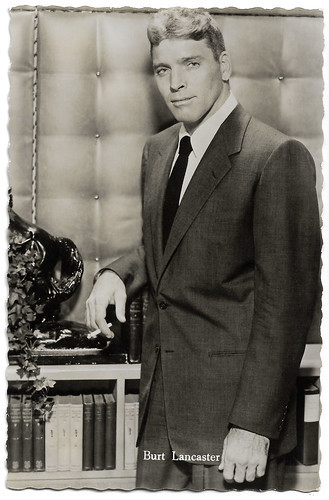
German postcard by Kolibri-Verlag, Minden/Westf. Photo: Warner Bros. Burt Lancaster in His Majesty O'Keefe (Byron Haskin, 1954). Collection: Geoffrey Donaldson Institute.
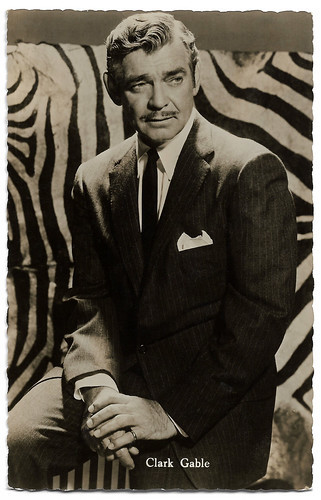
German postcard by Kolibri-Verlag, Minden/Westf., no. 218. Photo: Warner Bros. Clark Gable in Band of Angels (Raoul Walsh, 1957). Collection: Geoffrey Donaldson Institute.
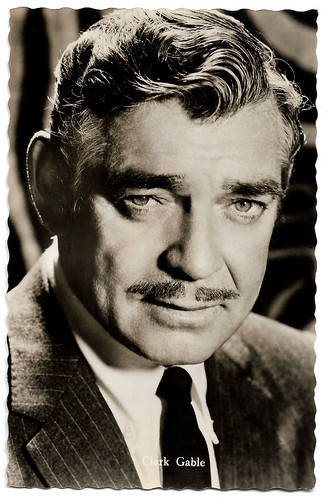
German postcard by Kolibri-Verlag, Minden/Westf., no. 600. Photo: Warner Bros. Clark Gable in Band of Angels (Raoul Walsh, 1957). Collection: Geoffrey Donaldson Institute.
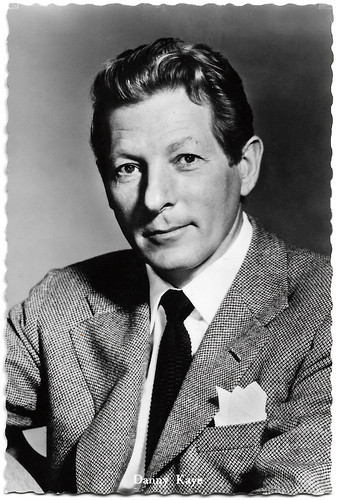
Dutch postcard by N.V. v.h. Weenenk & Snel, Baarn, no. 1060. Photo: M.G.M. Danny Kaye in Merry Andrew (Michael Kidd, 1958). Collection: Geoffrey Donaldson Institute.
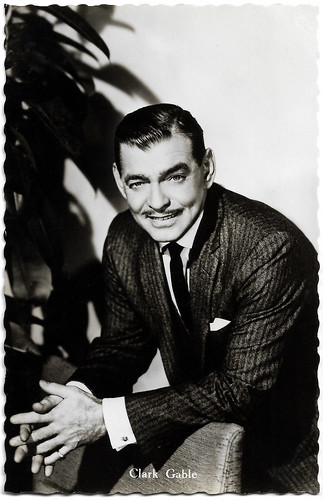
Dutch postcard by N.V. v.h. Weenenk & Snel, Baarn, no. 160. Photo: Paramount. Clark Gable in But Not For Me (Walter Lang, 1959). Collection: Geoffrey Donaldson Institute.
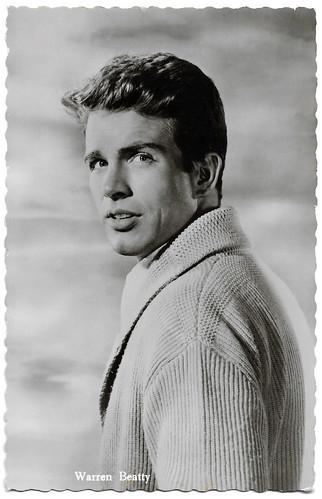
Warren Beatty. Dutch postcard, no. 662. Collection: Geoffrey Donaldson Institute.

Yul Brynner . Dutch postcard, no. 960. Collection: Geoffrey Donaldson Institute.
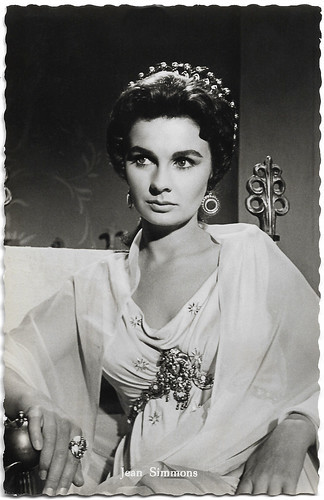
Dutch postcard, no. 860. Photo: Universal-Film. Jean Simmons in Spartacus (Stanley Kubrick, 1960). Collection: Geoffrey Donaldson Institute.
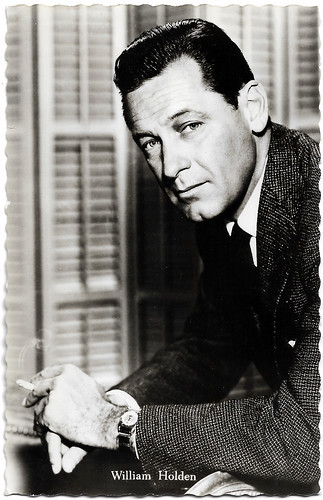
William Holden. German postcard by Kolibri Verlag, Minden/Westf. Photo: Warner Bros. Collection: Geoffrey Donaldson Institute.
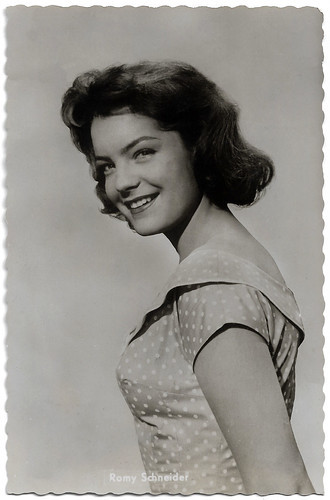
Romy Schneider . Dutch postcard by N.V. v.h. Weenenk & Snel, Baarn, no. 759. Collection: Geoffrey Donaldson Institute.
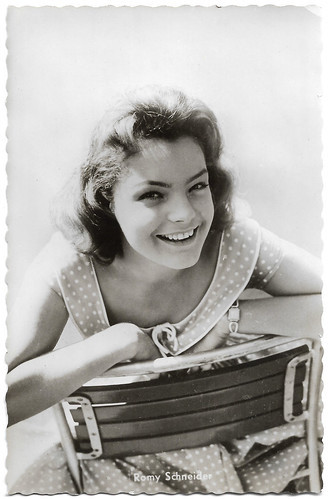
Romy Schneider . Dutch postcard by N.V. v.h. Weenenk & Snel, Baarn, no. 759 (yes, same number). Collection: Geoffrey Donaldson Institute.
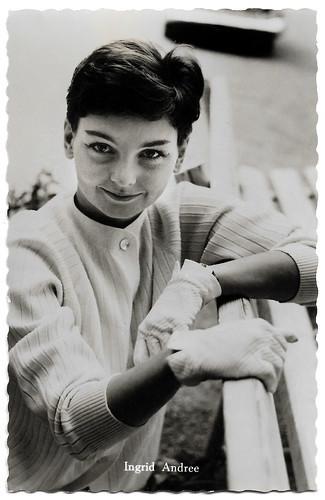
Ingrid Andree . Dutch postcard. Collection: Geoffrey Donaldson Institute.
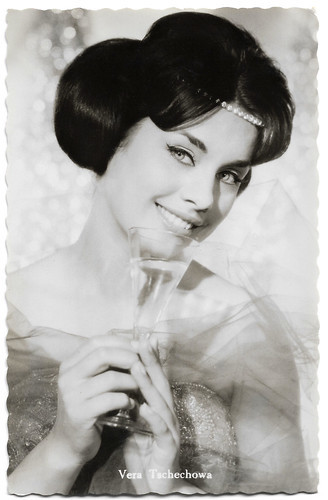
Vera Tschechowa . German postcard. Collection: Geoffrey Donaldson Institute.
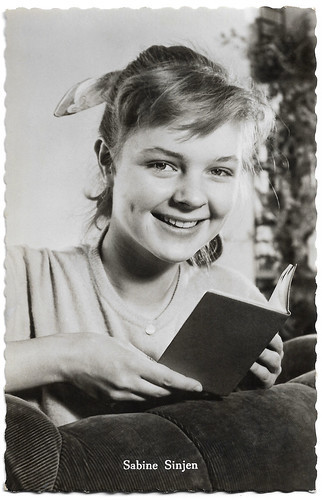
Sabine Sinjen . Dutch postcard. Collection: Geoffrey Donaldson Institute.
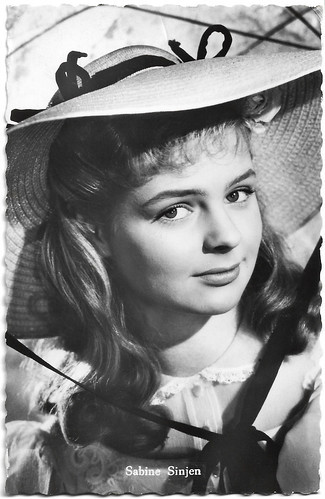
Dutch postcard by N.V. v.h. Weenenk & Snel, Baarn, no. 306. Sabine Sinjen in Alt Heidelberg/Old Heidelberg (Ernst Marischka, 1959). Collection: Geoffrey Donaldson Institute.
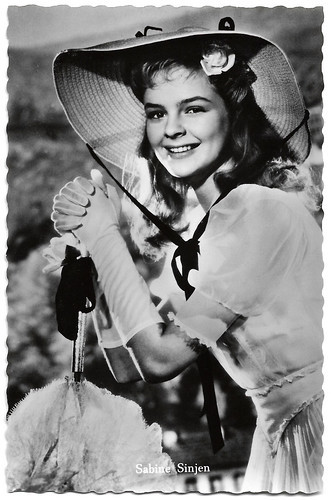
Dutch postcard, no. 1060. Sabine Sinjen in Alt Heidelberg/Old Heidelberg (Ernst Marischka, 1959). Collection: Geoffrey Donaldson Institute.
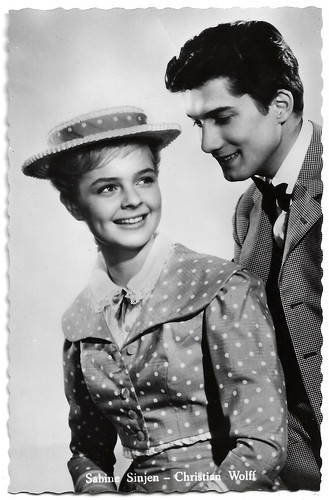
Dutch postcard by N.V. v.h. Weenenk & Snel, Baarn, no. 1066. Sabine Sinjen and Christian Wolff in Alt Heidelberg/Old Heidelberg (Ernst Marischka, 1959). Collection: Geoffrey Donaldson Institute.
The second album is the subject of tomorrow's post. So stay tuned! And many thanks to Egbert!

German postcard by Kolibri-Verlag, Minden/Westf. Photo: Warner Bros. Burt Lancaster in His Majesty O'Keefe (Byron Haskin, 1954). Collection: Geoffrey Donaldson Institute.

German postcard by Kolibri-Verlag, Minden/Westf., no. 218. Photo: Warner Bros. Clark Gable in Band of Angels (Raoul Walsh, 1957). Collection: Geoffrey Donaldson Institute.

German postcard by Kolibri-Verlag, Minden/Westf., no. 600. Photo: Warner Bros. Clark Gable in Band of Angels (Raoul Walsh, 1957). Collection: Geoffrey Donaldson Institute.

Dutch postcard by N.V. v.h. Weenenk & Snel, Baarn, no. 1060. Photo: M.G.M. Danny Kaye in Merry Andrew (Michael Kidd, 1958). Collection: Geoffrey Donaldson Institute.

Dutch postcard by N.V. v.h. Weenenk & Snel, Baarn, no. 160. Photo: Paramount. Clark Gable in But Not For Me (Walter Lang, 1959). Collection: Geoffrey Donaldson Institute.

Warren Beatty. Dutch postcard, no. 662. Collection: Geoffrey Donaldson Institute.

Yul Brynner . Dutch postcard, no. 960. Collection: Geoffrey Donaldson Institute.

Dutch postcard, no. 860. Photo: Universal-Film. Jean Simmons in Spartacus (Stanley Kubrick, 1960). Collection: Geoffrey Donaldson Institute.

William Holden. German postcard by Kolibri Verlag, Minden/Westf. Photo: Warner Bros. Collection: Geoffrey Donaldson Institute.

Romy Schneider . Dutch postcard by N.V. v.h. Weenenk & Snel, Baarn, no. 759. Collection: Geoffrey Donaldson Institute.

Romy Schneider . Dutch postcard by N.V. v.h. Weenenk & Snel, Baarn, no. 759 (yes, same number). Collection: Geoffrey Donaldson Institute.

Ingrid Andree . Dutch postcard. Collection: Geoffrey Donaldson Institute.

Vera Tschechowa . German postcard. Collection: Geoffrey Donaldson Institute.

Sabine Sinjen . Dutch postcard. Collection: Geoffrey Donaldson Institute.

Dutch postcard by N.V. v.h. Weenenk & Snel, Baarn, no. 306. Sabine Sinjen in Alt Heidelberg/Old Heidelberg (Ernst Marischka, 1959). Collection: Geoffrey Donaldson Institute.

Dutch postcard, no. 1060. Sabine Sinjen in Alt Heidelberg/Old Heidelberg (Ernst Marischka, 1959). Collection: Geoffrey Donaldson Institute.

Dutch postcard by N.V. v.h. Weenenk & Snel, Baarn, no. 1066. Sabine Sinjen and Christian Wolff in Alt Heidelberg/Old Heidelberg (Ernst Marischka, 1959). Collection: Geoffrey Donaldson Institute.
The second album is the subject of tomorrow's post. So stay tuned! And many thanks to Egbert!
Published on August 23, 2019 22:00
August 22, 2019
Giovanna Ralli
Since 1942, Italian actress Giovanna Ralli (1935) appeared in more than 80 films and TV series and during her career she worked with some of the greatest directors of the Italian cinema such as Vittorio de Sica, Federico Fellini, Roberto Rossellini and Ettore Scola. Twice she won the prestigious Nastri d'Argento award, including one for her supporting role in Scola’s classic comedy C'eravamo tanto amati (1974).
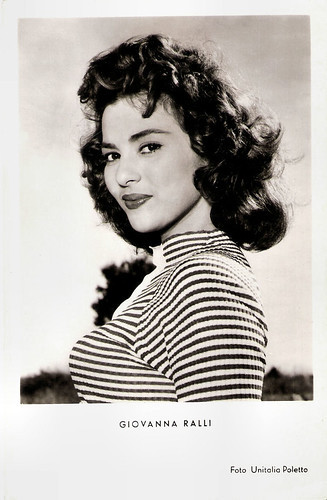
German postcard by Kunst und Bild, Berlin, no. S 520, Photo: Unitalia / Poletto.
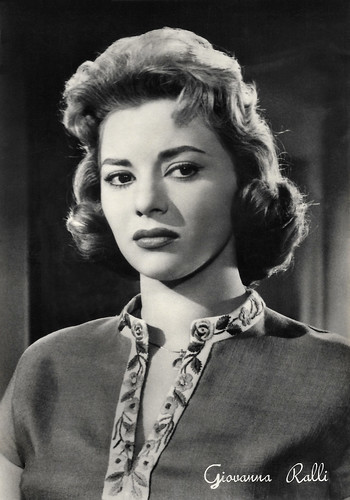
Italian postcard by Rotalfoto, Milano, no. 484, Photo: Carlo Ponti.
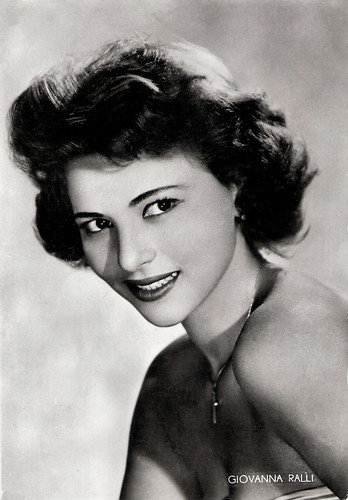
Italian postcard, no. 453.
Fresh Beauty
Giovanna Ralli was born in Rome, Italy in 1935. She is the sister of actress Patrizia Lari.
Ralli began her screen career at the age of seven with bit roles in films like La maestrina/The school teacher (Giorgio Bianchi, 1942) starring María Denis , and Vittorio de Sica ’s I bambini ci guardano/The Children Are Watching Us (1942).
Still very young she played many small parts in such films as the comedy Signori, in carrozza/Rome-Paris-Rome (Luigi Zampa, 1951) and La famiglia Passaguai/The Passaguai Family (Aldo Fabrizi, 1951) as Aldo Fabrizi’s daughter.
Her most interesting film from this period was Federico Fellini’s directorial debutLuci del varietà/Variety Lights (1950), co-directed by Alberto Lattuada.
As she matured into a fresh beauty, she began to play tough, spontaneous young women. In the 1950s she stood out in films like Anni facile/Easy Years (Luigi Zampa, 1953), the anthology Amore in Città/Love in the City (Alberto Lattuada a.o., 1953), Villa Borghese/It Happened in the Park (Vittorio de Sica, Gianni Franciolini, 1953), Racconti romani/Roman Tales (Gianni Franciolini, 1955), and Le ragazze di San Frediano/Girls of San Frediano (Valerio Zurlini, 1954) with Rossana Podestà .
She also appeared opposite Alberto Sordi in Un eroe dei nostri tempi/A hero of our time (Mario Monicelli, 1955), and opposite Marcello Mastroianni in Il bigamo/The bigamist (Luciano Emmer, 1956).
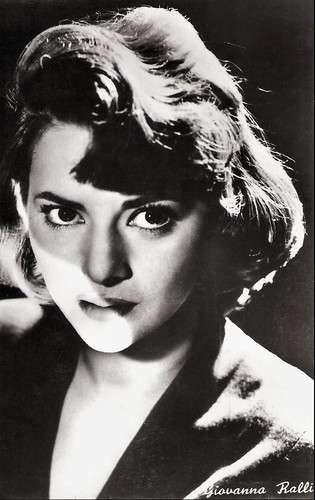
Spanish postcard by Soberanas, no. 205.
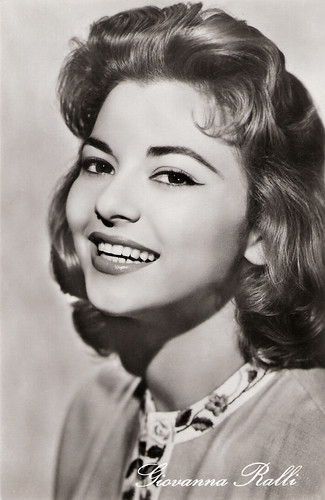
German postcard by VEB Progress-Filmvertrieb, Berlin.
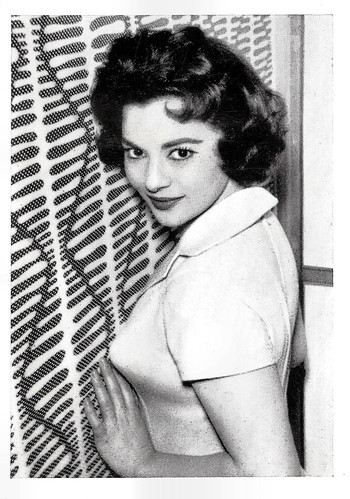
German cigarette card.
Good Dramatic Performer
Eventually Giovanna Ralli graduated to playing leads in Italian and international films. She proved to be a good dramatic performer in three films directed by the legendary Roberto Rossellini, the war dramas Il generale della Rovere/General della Rovere (1959) featuring Vittorio de Sica, Era notte a Roma/It was night in Rome (1960) with Renato Salvatori , and the historical drama Viva l'Italia!/Garibaldi (1961).
For her role in the lesbian romance La fuga/The Escape (Paolo Spinola, 1964) she won a Nastro d'Argento (the Silver Ribbon) as Best Actress.
She also played strong roles in the comedies La vita agra/Sour Life (Carlo Lizzani, 1964) opposite Ugo Tognazzi, and Se permettete parliamo di donne/Let's Talk About Women (Ettore Scola, 1964) starring Vittorio Gassman .
Her international productions include the war comedy What Did You Do in the War, Daddy? (Blake Edwards, 1966) with James Coburn, and the crime drama Deadfall (Bryan Forbes, 1968) with Michael Caine .
Ralli starred in a few Westerns: Le Goût de la violence/Taste of Violence (Robert Hossein, 1961), Il Mercenario/A Professional Gun (Sergio Corbucci, 1968) with Franco Nero , and the American production Cannon for Cordoba (Paul Wendkos, 1969) starring George Peppard.
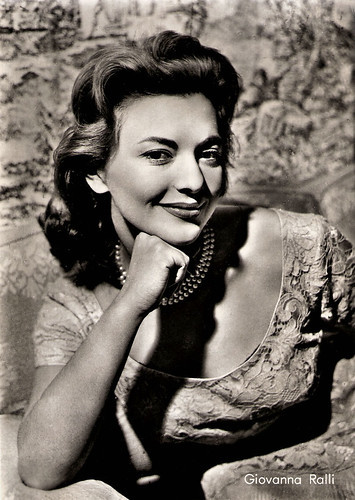
Italian postcard by Bromostampa, Milano, no. 189.
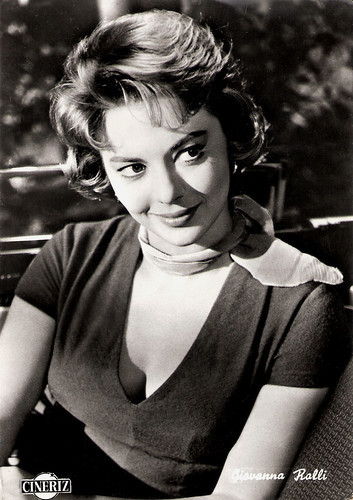
Italian postcard by Bromofoto, Milano (Milan), no. 1484. Photo: Cineriz.
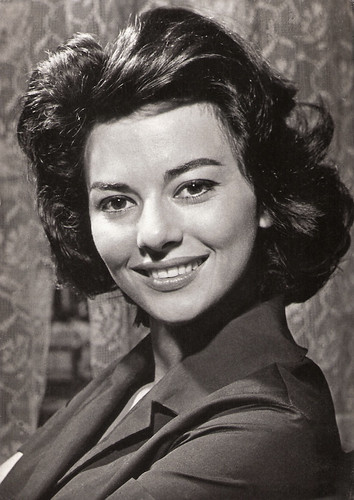
Czech postcard by Nakladatelstvi Orbis, Praha (Prague), no. F 03-03659. Retail price: 0,70 Kcs. Photo: Wilém Rosegnal.
Successful Comedies
During the 1970s Giovanna Ralli returned in some successful comedies, including Ettore Scola’s C'eravamo tanto amati/We All Loved Each Other So Much (1974). Once again she played Aldo Fabrizi’s daughter in the film, for which role she won her second Nastro d'Argento, now as Best Supporting Actress. Another hit was Di che segno sei?/What's your sign? (Sergio Corbucci, 1975).
She also appeared in another popular genre, the Giallo La polizia chiede aiuto/The Coed Murders (Massimo Dallamano, 1974) opposite Mario Adorf .
In 1977 she married Ettore Boschi. From the 1980s on, she appeared mainly on stage and in television productions, like the Rai TV series Un prete tra noi/A priest among us (Giorgio Capitani, Lodovico Gasparini, 1997) and Ho sposato uno sbirro/I Married A Cop (2008) in which she played the mother of Flavio Insinna.
Her later films include Verso sera/In the evening (Francesca Archibugi, 1991) with Marcello Mastroianni , and Il pranzo della domenica/ Sunday lunch (Carlo Vanzina, 2003) with Massimo Ghini, for which she was again nominated for a Nastro d'Argento as Best Supporting Actress. (She did not win this time.)
In 1993 she obtained the Flaiano Award for Lifetime Achievement for her theatrical and cinematic merits. In 2008 she also received the Premio Chioma di Berenice, another award for her whole career.
At the 2015 Taormina Film Fest, where Giovanna Ralli received a special award for her career, she announced her retirement from acting. The last films in which she appeared, are the comedies Immaturi/The Immature (Paolo Genovese, 2011), Immaturi - Il viaggio/The Immature - The Voyage (Paolo Genovese, 2012) and Un ragazzo d'oro/A Golden Boy (Pupi Avati, 2014), as the mother of Riccardo Scamarcio 's character.
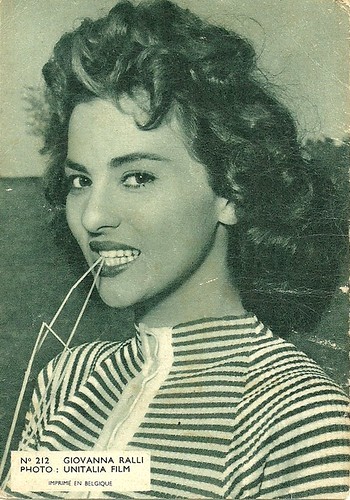
Belgian postcard, no. 212. Photo: Unitalia Film.
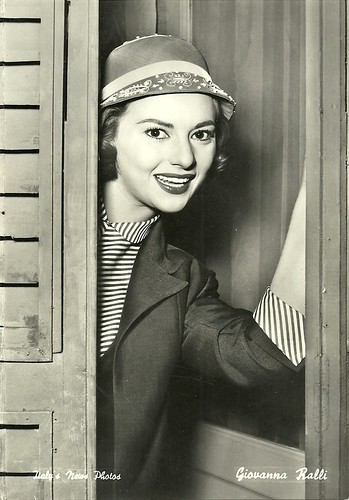
Italian postcard. Italy's New Photos.
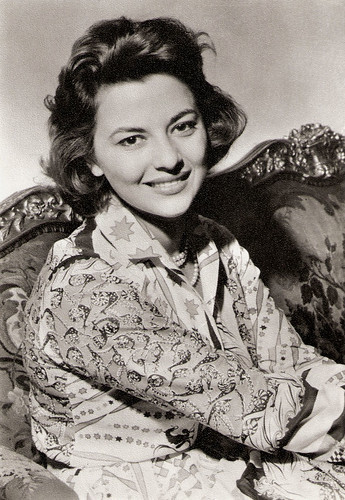
Czechoslovakian postcard by Nakladatelstvi Orbis, Praha (Prague), no. F 348009 077 841. Photo: Vilém Rosegnal.
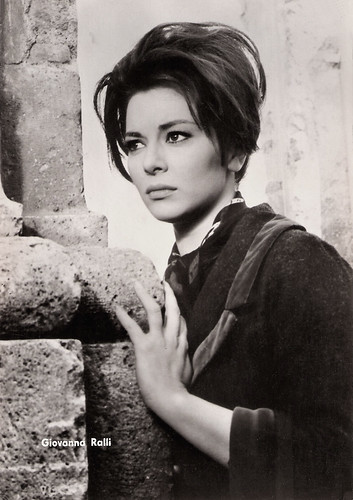
East-German postcard by VEB Progress Film-Vertrieb, Berlin, no. 3194, 1968. Retail price: 0,20 MDN. Photo: Progress. Giovanna Ralli in Liolà/A Very Handy Man(Alessandro Blasetti, 1964).
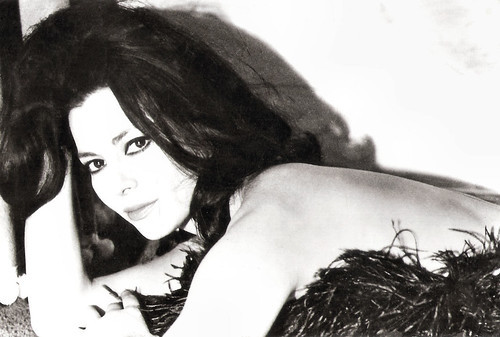
Romanian postcard by Casa Filmului Acin, no. 108.
Sources: Sandra Brennan (AllMovie), Wikipedia and .

German postcard by Kunst und Bild, Berlin, no. S 520, Photo: Unitalia / Poletto.

Italian postcard by Rotalfoto, Milano, no. 484, Photo: Carlo Ponti.

Italian postcard, no. 453.
Fresh Beauty
Giovanna Ralli was born in Rome, Italy in 1935. She is the sister of actress Patrizia Lari.
Ralli began her screen career at the age of seven with bit roles in films like La maestrina/The school teacher (Giorgio Bianchi, 1942) starring María Denis , and Vittorio de Sica ’s I bambini ci guardano/The Children Are Watching Us (1942).
Still very young she played many small parts in such films as the comedy Signori, in carrozza/Rome-Paris-Rome (Luigi Zampa, 1951) and La famiglia Passaguai/The Passaguai Family (Aldo Fabrizi, 1951) as Aldo Fabrizi’s daughter.
Her most interesting film from this period was Federico Fellini’s directorial debutLuci del varietà/Variety Lights (1950), co-directed by Alberto Lattuada.
As she matured into a fresh beauty, she began to play tough, spontaneous young women. In the 1950s she stood out in films like Anni facile/Easy Years (Luigi Zampa, 1953), the anthology Amore in Città/Love in the City (Alberto Lattuada a.o., 1953), Villa Borghese/It Happened in the Park (Vittorio de Sica, Gianni Franciolini, 1953), Racconti romani/Roman Tales (Gianni Franciolini, 1955), and Le ragazze di San Frediano/Girls of San Frediano (Valerio Zurlini, 1954) with Rossana Podestà .
She also appeared opposite Alberto Sordi in Un eroe dei nostri tempi/A hero of our time (Mario Monicelli, 1955), and opposite Marcello Mastroianni in Il bigamo/The bigamist (Luciano Emmer, 1956).

Spanish postcard by Soberanas, no. 205.

German postcard by VEB Progress-Filmvertrieb, Berlin.

German cigarette card.
Good Dramatic Performer
Eventually Giovanna Ralli graduated to playing leads in Italian and international films. She proved to be a good dramatic performer in three films directed by the legendary Roberto Rossellini, the war dramas Il generale della Rovere/General della Rovere (1959) featuring Vittorio de Sica, Era notte a Roma/It was night in Rome (1960) with Renato Salvatori , and the historical drama Viva l'Italia!/Garibaldi (1961).
For her role in the lesbian romance La fuga/The Escape (Paolo Spinola, 1964) she won a Nastro d'Argento (the Silver Ribbon) as Best Actress.
She also played strong roles in the comedies La vita agra/Sour Life (Carlo Lizzani, 1964) opposite Ugo Tognazzi, and Se permettete parliamo di donne/Let's Talk About Women (Ettore Scola, 1964) starring Vittorio Gassman .
Her international productions include the war comedy What Did You Do in the War, Daddy? (Blake Edwards, 1966) with James Coburn, and the crime drama Deadfall (Bryan Forbes, 1968) with Michael Caine .
Ralli starred in a few Westerns: Le Goût de la violence/Taste of Violence (Robert Hossein, 1961), Il Mercenario/A Professional Gun (Sergio Corbucci, 1968) with Franco Nero , and the American production Cannon for Cordoba (Paul Wendkos, 1969) starring George Peppard.

Italian postcard by Bromostampa, Milano, no. 189.

Italian postcard by Bromofoto, Milano (Milan), no. 1484. Photo: Cineriz.

Czech postcard by Nakladatelstvi Orbis, Praha (Prague), no. F 03-03659. Retail price: 0,70 Kcs. Photo: Wilém Rosegnal.
Successful Comedies
During the 1970s Giovanna Ralli returned in some successful comedies, including Ettore Scola’s C'eravamo tanto amati/We All Loved Each Other So Much (1974). Once again she played Aldo Fabrizi’s daughter in the film, for which role she won her second Nastro d'Argento, now as Best Supporting Actress. Another hit was Di che segno sei?/What's your sign? (Sergio Corbucci, 1975).
She also appeared in another popular genre, the Giallo La polizia chiede aiuto/The Coed Murders (Massimo Dallamano, 1974) opposite Mario Adorf .
In 1977 she married Ettore Boschi. From the 1980s on, she appeared mainly on stage and in television productions, like the Rai TV series Un prete tra noi/A priest among us (Giorgio Capitani, Lodovico Gasparini, 1997) and Ho sposato uno sbirro/I Married A Cop (2008) in which she played the mother of Flavio Insinna.
Her later films include Verso sera/In the evening (Francesca Archibugi, 1991) with Marcello Mastroianni , and Il pranzo della domenica/ Sunday lunch (Carlo Vanzina, 2003) with Massimo Ghini, for which she was again nominated for a Nastro d'Argento as Best Supporting Actress. (She did not win this time.)
In 1993 she obtained the Flaiano Award for Lifetime Achievement for her theatrical and cinematic merits. In 2008 she also received the Premio Chioma di Berenice, another award for her whole career.
At the 2015 Taormina Film Fest, where Giovanna Ralli received a special award for her career, she announced her retirement from acting. The last films in which she appeared, are the comedies Immaturi/The Immature (Paolo Genovese, 2011), Immaturi - Il viaggio/The Immature - The Voyage (Paolo Genovese, 2012) and Un ragazzo d'oro/A Golden Boy (Pupi Avati, 2014), as the mother of Riccardo Scamarcio 's character.

Belgian postcard, no. 212. Photo: Unitalia Film.

Italian postcard. Italy's New Photos.

Czechoslovakian postcard by Nakladatelstvi Orbis, Praha (Prague), no. F 348009 077 841. Photo: Vilém Rosegnal.

East-German postcard by VEB Progress Film-Vertrieb, Berlin, no. 3194, 1968. Retail price: 0,20 MDN. Photo: Progress. Giovanna Ralli in Liolà/A Very Handy Man(Alessandro Blasetti, 1964).

Romanian postcard by Casa Filmului Acin, no. 108.
Sources: Sandra Brennan (AllMovie), Wikipedia and .
Published on August 22, 2019 22:00
August 21, 2019
Volker von Collande
German actor, screenwriter and film director Volker von Collande (1913-1990) appeared in more than 40 films between 1934 and 1987. A member of the Nazi Party, he usually played upstanding citizens or men in uniform. Von Collande also directed more than 20 films between 1942 and 1967.
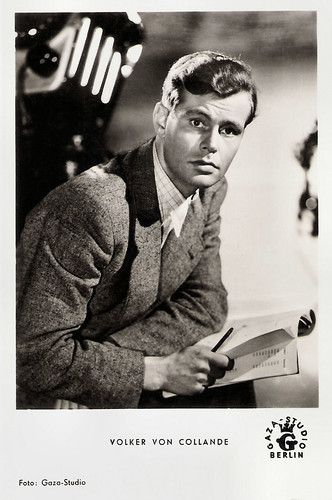
German postcard by Kunst und Bild, Berlin, no. A 290. Photo: Gaza-Studio, Berlin.
Looking for a pen pal called Gisela
Volker Hubertus Valentin Maria von Mitschke-Collande was born in Dresden in 1913 in a Silesian noble family. He was the son of the painter Constantin von Mitschke-Collande and his first wife Hilde Wiecke, whose father Paul Wiecke was an actor and theatre director in Dresden. His younger sister Gisela von Collande became a well known actress.
Collande started his career as a bricklayer apprentice and then completed an architecture degree at the State School Dresden. Only then did he take acting lessons and he made his stage debut in 1933 at the Deutsches Theater Berlin as Valentin in 'Faust'. In the same year he started to work as an assistant director and radio announcer in Stuttgart.
He became a member of the NSDAP, the Nazi party. From 1933 on, he performed in over 30 feature films. He played supporting parts in the Karl Valentin comedy Donner, Blitz und Sonnenschein/Thunder, Lightning and Sunshine (Erich Engels, 1936), and the drama Waldwinter/Winter in the Woods (Fritz Peter Buch, 1936) starring Viktor Staal and Hansi Knoteck .
For the Ufa, he appeared in the romances Eine Frau wie Du/A Woman Like You (Viktor Tourjansky, 1939) starring Brigitte Horney , and Ihr erstes Erlebnis/Her First Experience (Josef von Báky, 1939) starring Ilse Werner .
He directed his first film in 1942: the romantic comedy Zwei in einer großen Stadt/Two in a Big City (Volker von Collande, 1942) starring Claude Farell , Karl John and Marianne Simson . A German soldier on leave in Berlin goes looking for his pen pal who he has never met called Gisela. He meets instead a woman with the same name and falls in love with her.
A hit was his next film, the comedy Das Bad auf der Tenne/The Bath in the Barn (Volker von Collande, 1943) starring Will Dohm and Heli Finkenzeller. In the meanwhile, he worked as a stage actor in Berlin, and as a director of radio plays.
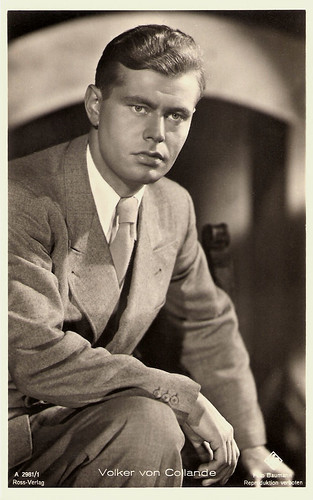
German postcard by Ross Verlag, no. A 2981/1, 1939-1940. Photo: Baumann / Ufa.
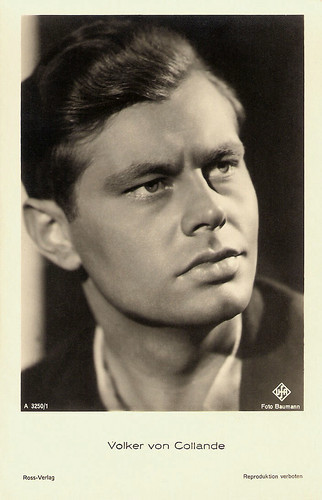
German postcard by Ross Verlag, no. A 3250/1, 1941-1944. Photo: Baumann / Ufa.
Uninterested direction
From 1947 on, Victor von Collande worked for the theatre in Saarbrücken and during the 1950s he performed at the Deutsches Schauspielhaus in Hamburg.
He continued to work in the cinema. He appeared in such comedies as Absender unbekannt/Unknown Sender (Ákos Ráthonyi, 1950) starring Henny Porten . Among the films he directed were such light entertainment films as Ich warte auf dich/I'm Waiting for You (Volker von Collande, 1952, with Hanna Rucker and Joachim Brennecke .
Especially popular was the second part of the Immenhof series, Hochzeit auf Immenhof/Wedding at Immenhof (Volker von Collande, 1956), starring Heidi Brühl and Angelika Meissner .
J. Steed at IMDb : "Although in principal it did not matter much who sat in the director's chair, this part with its already weaker story (than that of part 1) is not helped much by Volker von Collande's uninterested direction. It is a good thing that Fritz Arno Wagner was behind the camera, although he could not prevent that when finally something resembling a plot is starting (with the arrival of Hans Nielsen as the financial saver), the story telling becomes untidy."
Von Collande moved to the new medium television and specialised himself in making TV films. Later he also worked as a theatre manager at the Theater Freiburg, at the Theater Regensburg and the Theater Wolfsburg and worked as a cultural consultant for the Volkswagen AG.
Von Collande was married four times. From 1936 till 1938 he was married to actress Ingeborg Hertel. In 1939, he married the dance teacher Gisela Hartwig gen. von Naso. They divorced in 1942. In 1944, he married the ballet master Isabella Vernici Modler, which marriage also ended in a divorce in 1950. Finally, he wed in a fourth marriage the voice therapist Irene Nathusius. Their daughter Nora von Collande became an actress and author.
Volker von Collande passed away in Hannover in 1990. He was buried at the Ohlsdorf cemetery.
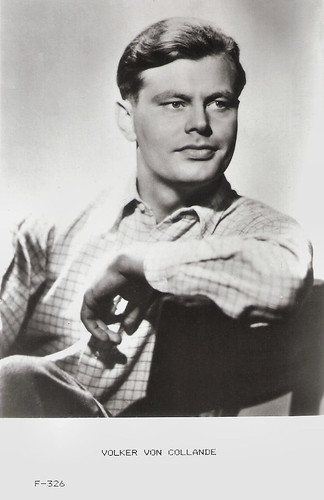
German postcard by Netter's Starverlag, Berlin, no. F-326.
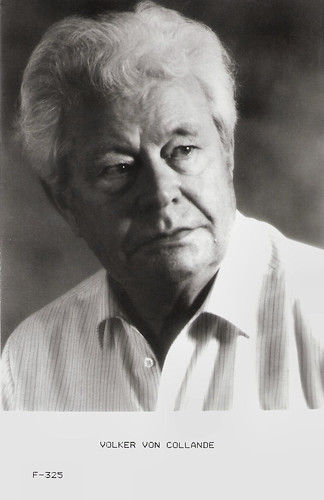
German postcard by Netter's Starverlag, Berlin, no. F-325.
Sources: Wikipedia (English and German) and .

German postcard by Kunst und Bild, Berlin, no. A 290. Photo: Gaza-Studio, Berlin.
Looking for a pen pal called Gisela
Volker Hubertus Valentin Maria von Mitschke-Collande was born in Dresden in 1913 in a Silesian noble family. He was the son of the painter Constantin von Mitschke-Collande and his first wife Hilde Wiecke, whose father Paul Wiecke was an actor and theatre director in Dresden. His younger sister Gisela von Collande became a well known actress.
Collande started his career as a bricklayer apprentice and then completed an architecture degree at the State School Dresden. Only then did he take acting lessons and he made his stage debut in 1933 at the Deutsches Theater Berlin as Valentin in 'Faust'. In the same year he started to work as an assistant director and radio announcer in Stuttgart.
He became a member of the NSDAP, the Nazi party. From 1933 on, he performed in over 30 feature films. He played supporting parts in the Karl Valentin comedy Donner, Blitz und Sonnenschein/Thunder, Lightning and Sunshine (Erich Engels, 1936), and the drama Waldwinter/Winter in the Woods (Fritz Peter Buch, 1936) starring Viktor Staal and Hansi Knoteck .
For the Ufa, he appeared in the romances Eine Frau wie Du/A Woman Like You (Viktor Tourjansky, 1939) starring Brigitte Horney , and Ihr erstes Erlebnis/Her First Experience (Josef von Báky, 1939) starring Ilse Werner .
He directed his first film in 1942: the romantic comedy Zwei in einer großen Stadt/Two in a Big City (Volker von Collande, 1942) starring Claude Farell , Karl John and Marianne Simson . A German soldier on leave in Berlin goes looking for his pen pal who he has never met called Gisela. He meets instead a woman with the same name and falls in love with her.
A hit was his next film, the comedy Das Bad auf der Tenne/The Bath in the Barn (Volker von Collande, 1943) starring Will Dohm and Heli Finkenzeller. In the meanwhile, he worked as a stage actor in Berlin, and as a director of radio plays.

German postcard by Ross Verlag, no. A 2981/1, 1939-1940. Photo: Baumann / Ufa.

German postcard by Ross Verlag, no. A 3250/1, 1941-1944. Photo: Baumann / Ufa.
Uninterested direction
From 1947 on, Victor von Collande worked for the theatre in Saarbrücken and during the 1950s he performed at the Deutsches Schauspielhaus in Hamburg.
He continued to work in the cinema. He appeared in such comedies as Absender unbekannt/Unknown Sender (Ákos Ráthonyi, 1950) starring Henny Porten . Among the films he directed were such light entertainment films as Ich warte auf dich/I'm Waiting for You (Volker von Collande, 1952, with Hanna Rucker and Joachim Brennecke .
Especially popular was the second part of the Immenhof series, Hochzeit auf Immenhof/Wedding at Immenhof (Volker von Collande, 1956), starring Heidi Brühl and Angelika Meissner .
J. Steed at IMDb : "Although in principal it did not matter much who sat in the director's chair, this part with its already weaker story (than that of part 1) is not helped much by Volker von Collande's uninterested direction. It is a good thing that Fritz Arno Wagner was behind the camera, although he could not prevent that when finally something resembling a plot is starting (with the arrival of Hans Nielsen as the financial saver), the story telling becomes untidy."
Von Collande moved to the new medium television and specialised himself in making TV films. Later he also worked as a theatre manager at the Theater Freiburg, at the Theater Regensburg and the Theater Wolfsburg and worked as a cultural consultant for the Volkswagen AG.
Von Collande was married four times. From 1936 till 1938 he was married to actress Ingeborg Hertel. In 1939, he married the dance teacher Gisela Hartwig gen. von Naso. They divorced in 1942. In 1944, he married the ballet master Isabella Vernici Modler, which marriage also ended in a divorce in 1950. Finally, he wed in a fourth marriage the voice therapist Irene Nathusius. Their daughter Nora von Collande became an actress and author.
Volker von Collande passed away in Hannover in 1990. He was buried at the Ohlsdorf cemetery.

German postcard by Netter's Starverlag, Berlin, no. F-326.

German postcard by Netter's Starverlag, Berlin, no. F-325.
Sources: Wikipedia (English and German) and .
Published on August 21, 2019 22:00
August 20, 2019
Alice Joyce
Alice Joyce (1890-1955) was an American silent screen actress, who appeared in more than 200 films during the 1910s and 1920s. Joyce spent time with Kalem (1910–1915) and Vitagraph (1916–1921), and later worked freelance for various studios. At the peak of her career, she was nicknamed 'the Madonna of the Screen'.

British postcard. Photo: Kalem.
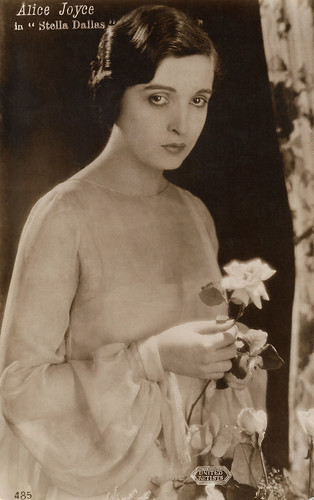
Italian postcard by Casa Editrice Ballerini & Fratini, Firenze, no. 485. Photo: United Artists. Alice Joyce in Stella Dallas (Henry King, 1925).

Austrian postcard by Iris Verlag, no. 749. Photo: Fanamet.
Well-behaved ladies of the better society
Alice Joyce was born in Kansas City, Missouri, in 1890. Her parents were John Edward Joyce, a smelter worker, and Vallie Olive McIntyre Joyce, a seamstress. She had a younger brother, Francis 'Frank' Joyce, who later became an entertainment manager.
She began her career at 13 as a telephone operator, modeling on the side in the summer when business was slow. Due to her striking looks, she became one of the top models for commercial artists in Kansas City.
She obtained a try-out at Biograph Pictures but was rejected by D.W. Griffith. It was director Sidney Olcott at the Kalem Company in New York City who gave Alice Joyce her first chance, casting her in his production, The Deacon's Daughter (Sidney Olcott, 1910).
Joyce quickly rose to become one of the biggest stars of Kalem Studios. Jon C. Hopwood at IMDb : "Kalem was one of the first companies to break the movie industry practice of not crediting its performers, and it began to feature Alice in its publicity and advertising. By April 1911 she was already being cited by name in reviews, and she soon became well-known. Returning to New York in the summer of 1912, Joyce was now a popular screen favorite and Kalem's biggest star. She even appeared as herself in Rube Marquard Wins (1912), a two-reeler featuring the future baseball Hall of Famer, who had set a major-league record with 19 straight wins that year for the pennant-winning New York Giants."
Alice played mostly well-behaved ladies of the better society in melodramas, comedies and occasionally crime stories. She was eventually sent to work under director Kenean Buel on the West Coast after Kalem acquired the old Essanay Studios property in East Hollywood in October 1913.
The leading man for many of her films in this period was Tom Moore, one of a famous family of Irish actors. Eventually, Tom and Alice fell in love and were married in 1914, while on location for The Girl and the Stowaway (Kenean Buel, 1914) in Jacksonville, Florida.
In the middle of 1914, Kalem launched the two-reel 'Alice Joyce Series', releasing a new film of hers every two weeks. The studio transferred Moore to another film unit to co-star with Marguerite Courtot, while Guy Coombs was made Joyce's new leading man.
With the merger of Kalem with Vitagraph in 1916, the popularity of Joyce increased. Feature films had pushed one- and two-reelers out of the marketplace as nickelodeons were replaced by converted vaudeville houses and movie cathedrals. Joyce was cast into two of J. Stuart Blackton's films: Whom the Gods Destroy (1916), a near-contemporaneous tale of the Easter Rebellion in Ireland, and the patriotic potboiler Womanhood, the Glory of the Nation (1917).
Her biggest hit was Within the Law (William P.S. Earle, 1917), the film version of Bayard Veiller's vastly popular stage melodrama, in which she played Mary Turner, a young shopgirl unjustly convicted of a crime and sentenced to prison. There she studies the law and comes to the conclusion that there are many ways to break the law.

British postcard. Photo: Kalem.

British postcard in the Famous Cinema Star Series by Beagles & Co, Ltd, no. 147.A.
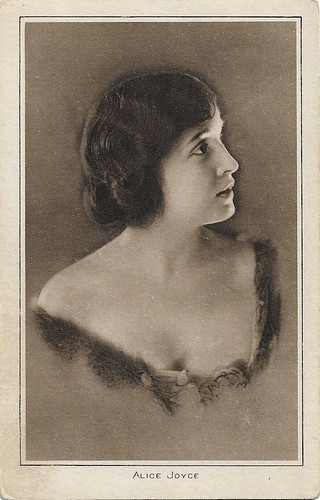
British postcard in the "Pictures" Portrait Gallery, no. 125.
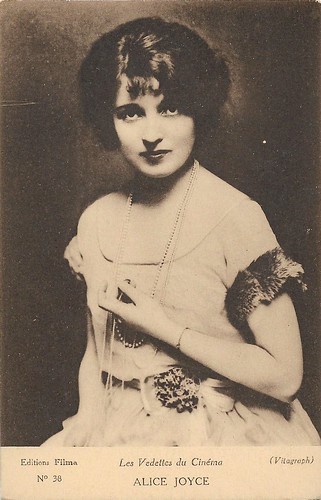
French postcard in the Les Vedettes du Cinéma series by Editions Filma, no. 38. Photo: Vitagraph.
A well-endowed contract with First National
Alice Joyce was known as 'The Madonna of the Screen' for her striking features and presence. Until 1921, Joyce played mostly naive ingénue roles for Vitagraph, but slowly as she started to work independently, she also took on some more mature roles. She appeared in The Green Goddess (Sidney Olcott, 1923) opposite the great stage actor George Arliss .
In 1924 she acted opposite Clive Brook in the British production The Passionate Adventure (Graham Cutts, 1924). The screenplay was co-written by a young filmmaker named Alfred Hitchcock, who also served as art director.
1925 was one of her most productive years. She played opposite Percy Marmont in Frank Borzage's Daddy's Gone A-Hunting and was Stella's rival Helen Morrison in Henry King's Stella Dallas.
Five months later she played Clara Bow's mother in Dancing Mothers (Herbert Brenon, 1926). She played a woman who is denied any pleasure in life by her heartless husband and thoughtless daughter. It was one of Joyce greatest successes. She also played a princess opposite W.C. Fields in the comedy So's Your Old Man (Gregory La Cava, 1926).
In 1927 Joyce signed a well-endowed contract with First National, where she received a few substantial film roles, as in The Squall (Alexander Korda, 1929), starring Myrna Loy and Loretta Young, and based on the 1926 play The Squall by Jean Bart.
Joyce made a smooth transition from silent film to sound film and co-acted with George Arliss in The Green Goddess (Alfred E. Green, 1930), the remake of a film in which both stars had had a success in 1923. Arliss was nominated for an Academy Award for Best Actor in a Leading Role for his performance.
In 1930, she also made her last film, Song o' My Heart (Frank Borzage, 1930), after which she and ex-husband Tom Moore worked a late vaudeville circuit for a time. A lengthy heart disease ( Louise Brooks claimed that it was an alcohol problem) forced her into private life. She declared voluntary bankruptcy in 1933.
Alice Joyce was first married to actor Tom Moore (1914-1920) with whom she had a daughter, Alice Joyce Moore (1916–1960). Then she was married to James Regan (1920-1932), son of the managing director of the old Knickerbocker Hotel. She had a second daughter with him, Margaret (Peggy) Regan.
Finally she married director Clarence Brown in 1933, a six-time Oscar nominee who was one of the studio's top directors. Joyce was active in San Fernando Valley women's organisations. She did book reviews and made sketches for friends. In 1946, after her divorce from Brown, Joyce was seriously injured in a traffic accident. Clarence Brown remained with her for nine hours and paid her medical bills.
The actress was ill for several years before her death from a blood and heart ailment at Hollywood Presbyterian Hospital. Alice Joyce died in 1955 at the age of 65. Joyce was interred next to her mother, Vallie, in the San Fernando Mission Cemetery in Mission Hills, Los Angeles, California.
Next to Mary Pickford and Lillian Gish , she was one of the few stars who was a star from the beginnings of commercial cinema, when it was still called Nickelodeon, right up to the sound film days.

French postcard by Editions Cinémagazine, no. 286.
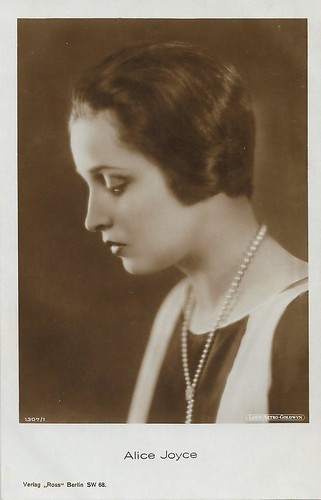
German postcard. Ross Verlag, no. 1307/1, 1927-1928. Photo: Loew-Metro-Goldwyn.

German postcard by Ross Verlag, no. 1442/1, 1927-1928. Photo: Paramount -Film.
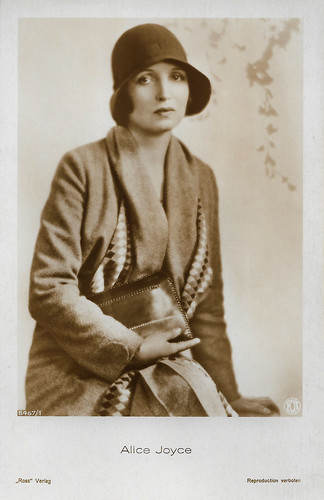
German postcard by Ross Verlag, no. 6467/1, 1931-1932. Photo: Fox.
Sources: (IMDb), Wikipedia (German and English) and .

British postcard. Photo: Kalem.

Italian postcard by Casa Editrice Ballerini & Fratini, Firenze, no. 485. Photo: United Artists. Alice Joyce in Stella Dallas (Henry King, 1925).

Austrian postcard by Iris Verlag, no. 749. Photo: Fanamet.
Well-behaved ladies of the better society
Alice Joyce was born in Kansas City, Missouri, in 1890. Her parents were John Edward Joyce, a smelter worker, and Vallie Olive McIntyre Joyce, a seamstress. She had a younger brother, Francis 'Frank' Joyce, who later became an entertainment manager.
She began her career at 13 as a telephone operator, modeling on the side in the summer when business was slow. Due to her striking looks, she became one of the top models for commercial artists in Kansas City.
She obtained a try-out at Biograph Pictures but was rejected by D.W. Griffith. It was director Sidney Olcott at the Kalem Company in New York City who gave Alice Joyce her first chance, casting her in his production, The Deacon's Daughter (Sidney Olcott, 1910).
Joyce quickly rose to become one of the biggest stars of Kalem Studios. Jon C. Hopwood at IMDb : "Kalem was one of the first companies to break the movie industry practice of not crediting its performers, and it began to feature Alice in its publicity and advertising. By April 1911 she was already being cited by name in reviews, and she soon became well-known. Returning to New York in the summer of 1912, Joyce was now a popular screen favorite and Kalem's biggest star. She even appeared as herself in Rube Marquard Wins (1912), a two-reeler featuring the future baseball Hall of Famer, who had set a major-league record with 19 straight wins that year for the pennant-winning New York Giants."
Alice played mostly well-behaved ladies of the better society in melodramas, comedies and occasionally crime stories. She was eventually sent to work under director Kenean Buel on the West Coast after Kalem acquired the old Essanay Studios property in East Hollywood in October 1913.
The leading man for many of her films in this period was Tom Moore, one of a famous family of Irish actors. Eventually, Tom and Alice fell in love and were married in 1914, while on location for The Girl and the Stowaway (Kenean Buel, 1914) in Jacksonville, Florida.
In the middle of 1914, Kalem launched the two-reel 'Alice Joyce Series', releasing a new film of hers every two weeks. The studio transferred Moore to another film unit to co-star with Marguerite Courtot, while Guy Coombs was made Joyce's new leading man.
With the merger of Kalem with Vitagraph in 1916, the popularity of Joyce increased. Feature films had pushed one- and two-reelers out of the marketplace as nickelodeons were replaced by converted vaudeville houses and movie cathedrals. Joyce was cast into two of J. Stuart Blackton's films: Whom the Gods Destroy (1916), a near-contemporaneous tale of the Easter Rebellion in Ireland, and the patriotic potboiler Womanhood, the Glory of the Nation (1917).
Her biggest hit was Within the Law (William P.S. Earle, 1917), the film version of Bayard Veiller's vastly popular stage melodrama, in which she played Mary Turner, a young shopgirl unjustly convicted of a crime and sentenced to prison. There she studies the law and comes to the conclusion that there are many ways to break the law.

British postcard. Photo: Kalem.

British postcard in the Famous Cinema Star Series by Beagles & Co, Ltd, no. 147.A.

British postcard in the "Pictures" Portrait Gallery, no. 125.

French postcard in the Les Vedettes du Cinéma series by Editions Filma, no. 38. Photo: Vitagraph.
A well-endowed contract with First National
Alice Joyce was known as 'The Madonna of the Screen' for her striking features and presence. Until 1921, Joyce played mostly naive ingénue roles for Vitagraph, but slowly as she started to work independently, she also took on some more mature roles. She appeared in The Green Goddess (Sidney Olcott, 1923) opposite the great stage actor George Arliss .
In 1924 she acted opposite Clive Brook in the British production The Passionate Adventure (Graham Cutts, 1924). The screenplay was co-written by a young filmmaker named Alfred Hitchcock, who also served as art director.
1925 was one of her most productive years. She played opposite Percy Marmont in Frank Borzage's Daddy's Gone A-Hunting and was Stella's rival Helen Morrison in Henry King's Stella Dallas.
Five months later she played Clara Bow's mother in Dancing Mothers (Herbert Brenon, 1926). She played a woman who is denied any pleasure in life by her heartless husband and thoughtless daughter. It was one of Joyce greatest successes. She also played a princess opposite W.C. Fields in the comedy So's Your Old Man (Gregory La Cava, 1926).
In 1927 Joyce signed a well-endowed contract with First National, where she received a few substantial film roles, as in The Squall (Alexander Korda, 1929), starring Myrna Loy and Loretta Young, and based on the 1926 play The Squall by Jean Bart.
Joyce made a smooth transition from silent film to sound film and co-acted with George Arliss in The Green Goddess (Alfred E. Green, 1930), the remake of a film in which both stars had had a success in 1923. Arliss was nominated for an Academy Award for Best Actor in a Leading Role for his performance.
In 1930, she also made her last film, Song o' My Heart (Frank Borzage, 1930), after which she and ex-husband Tom Moore worked a late vaudeville circuit for a time. A lengthy heart disease ( Louise Brooks claimed that it was an alcohol problem) forced her into private life. She declared voluntary bankruptcy in 1933.
Alice Joyce was first married to actor Tom Moore (1914-1920) with whom she had a daughter, Alice Joyce Moore (1916–1960). Then she was married to James Regan (1920-1932), son of the managing director of the old Knickerbocker Hotel. She had a second daughter with him, Margaret (Peggy) Regan.
Finally she married director Clarence Brown in 1933, a six-time Oscar nominee who was one of the studio's top directors. Joyce was active in San Fernando Valley women's organisations. She did book reviews and made sketches for friends. In 1946, after her divorce from Brown, Joyce was seriously injured in a traffic accident. Clarence Brown remained with her for nine hours and paid her medical bills.
The actress was ill for several years before her death from a blood and heart ailment at Hollywood Presbyterian Hospital. Alice Joyce died in 1955 at the age of 65. Joyce was interred next to her mother, Vallie, in the San Fernando Mission Cemetery in Mission Hills, Los Angeles, California.
Next to Mary Pickford and Lillian Gish , she was one of the few stars who was a star from the beginnings of commercial cinema, when it was still called Nickelodeon, right up to the sound film days.

French postcard by Editions Cinémagazine, no. 286.

German postcard. Ross Verlag, no. 1307/1, 1927-1928. Photo: Loew-Metro-Goldwyn.

German postcard by Ross Verlag, no. 1442/1, 1927-1928. Photo: Paramount -Film.

German postcard by Ross Verlag, no. 6467/1, 1931-1932. Photo: Fox.
Sources: (IMDb), Wikipedia (German and English) and .
Published on August 20, 2019 22:00
August 19, 2019
Rosen aus dem Süden (1926)
Henny Porten and Italian actor Angelo Ferrari played the lead roles in the German silent romance Rosen aus dem Süden/Roses from the South (Carl Froehlich, 1926). It was another Henny Porten-Film production.
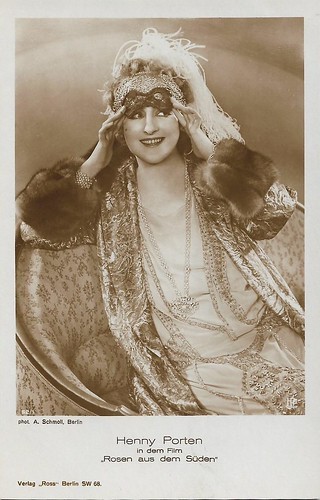
German postcard by Ross Verlag, no. 52/1. Photo: A. Schmoll, Berlin / Henny Porten-Film. Henny Porten in Rosen aus dem Süden/Roses from the South (Carl Froehlich, 1926).

German postcard by Ross Verlag, no. 52/2. Photo: A. Schmoll, Berlin / Henny Porten-Film. Henny Porten in Rosen aus dem Süden/Roses from the South (Carl Froehlich, 1926).
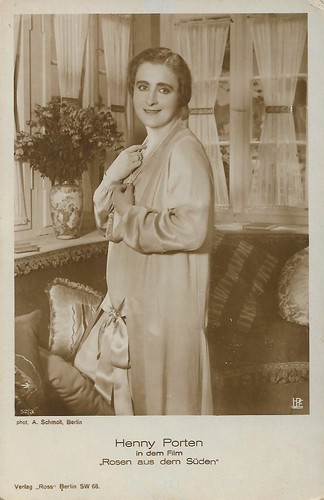
German postcard by Ross Verlag, no. 52/3. Photo: A. Schmoll, Berlin / Henny Porten-Film. Henny Porten in Rosen aus dem Süden/Roses from the South (Carl Froehlich, 1926).
Where the Wild Rose Blossoms
Rosen aus dem Süden/Roses from the South (Carl Froehlich, 1926) was based on a story by Walter Supper. Hans Oberländer and Walter Supper himself wrote the screenplay.
The film's title is a reference to the song 'Rosen aus dem Süden' by Johann Strauss II. The song is a waltz medley composed by Strauss II in 1880 with its themes drawn from the operetta 'Das Spitzentuch der Königin' (The Queen's Lace Handkerchief) inspired by a novel by Heinrich Bohrmann-Riegen.
The waltz was first performed at the regular Sunday concerts of the Strauss Orchestra conducted by Eduard Strauss on 7 November 1880 at the Musikverein in Vienna. Its themes drawn from the operetta are the act 1 'Trüffel-Couplet' and the act 2 romance 'Wo die wilde Rose erblüht' (Where the Wild Rose Blossoms). The act 2 romance most certainly inspired the title of this waltz.
The waltz ranks among the 'Waltz King's' magnificent works and is still regularly performed today at the Vienna Philharmonic's New Year's Concert.
Next to Henny Porten , the other leading roles in Rosen aus dem Süden/Roses from the South were played by Italian heartthrob Angelo Ferrari , Wilhelm Bendow, Hilde Wörner and Jenny Marba.
Axel Graatkjær was the cameraman and Franz Schroedter was art director. Production manager was Wilhelm von Kaufmann. The film premiered in Berlin on 11 March 1926.
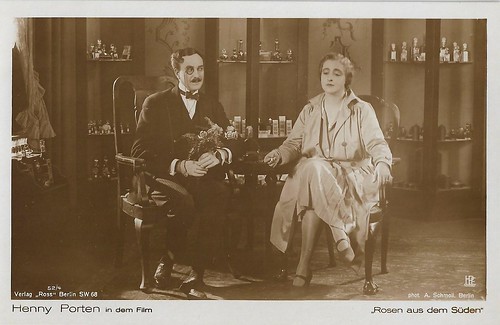
German postcard by Ross Verlag, no. 52/4. Photo: A. Schmoll, Berlin / Henny Porten-Film. Henny Porten in Rosen aus dem Süden/Roses from the South (Carl Froehlich, 1926). The man is Robert Scholz, who plays the French suitor, Armand Lawrence.
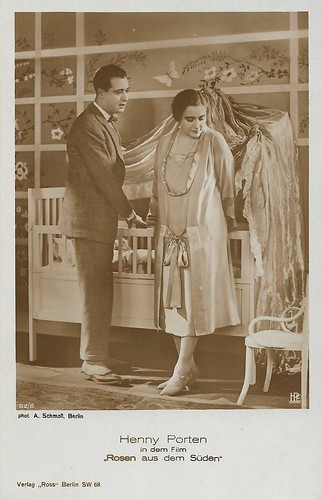
German postcard by Ross Verlag, no. 52/5. Photo: A. Schmoll, Berlin / Henny Porten-Film. Henny Porten and Angelo Ferrari in Rosen aus dem Süden/Roses from the South (Carl Froehlich, 1926).
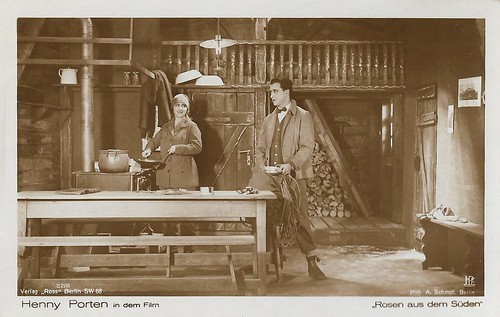
German postcard by Ross Verlag, no. 52/6. Photo: A. Schmoll, Berlin / Henny Porten-Film. Henny Porten and Angelo Ferrari in Rosen aus dem Süden/Roses from the South (Carl Froehlich, 1926).
Sources: Wikipedia and IMDb.

German postcard by Ross Verlag, no. 52/1. Photo: A. Schmoll, Berlin / Henny Porten-Film. Henny Porten in Rosen aus dem Süden/Roses from the South (Carl Froehlich, 1926).

German postcard by Ross Verlag, no. 52/2. Photo: A. Schmoll, Berlin / Henny Porten-Film. Henny Porten in Rosen aus dem Süden/Roses from the South (Carl Froehlich, 1926).

German postcard by Ross Verlag, no. 52/3. Photo: A. Schmoll, Berlin / Henny Porten-Film. Henny Porten in Rosen aus dem Süden/Roses from the South (Carl Froehlich, 1926).
Where the Wild Rose Blossoms
Rosen aus dem Süden/Roses from the South (Carl Froehlich, 1926) was based on a story by Walter Supper. Hans Oberländer and Walter Supper himself wrote the screenplay.
The film's title is a reference to the song 'Rosen aus dem Süden' by Johann Strauss II. The song is a waltz medley composed by Strauss II in 1880 with its themes drawn from the operetta 'Das Spitzentuch der Königin' (The Queen's Lace Handkerchief) inspired by a novel by Heinrich Bohrmann-Riegen.
The waltz was first performed at the regular Sunday concerts of the Strauss Orchestra conducted by Eduard Strauss on 7 November 1880 at the Musikverein in Vienna. Its themes drawn from the operetta are the act 1 'Trüffel-Couplet' and the act 2 romance 'Wo die wilde Rose erblüht' (Where the Wild Rose Blossoms). The act 2 romance most certainly inspired the title of this waltz.
The waltz ranks among the 'Waltz King's' magnificent works and is still regularly performed today at the Vienna Philharmonic's New Year's Concert.
Next to Henny Porten , the other leading roles in Rosen aus dem Süden/Roses from the South were played by Italian heartthrob Angelo Ferrari , Wilhelm Bendow, Hilde Wörner and Jenny Marba.
Axel Graatkjær was the cameraman and Franz Schroedter was art director. Production manager was Wilhelm von Kaufmann. The film premiered in Berlin on 11 March 1926.

German postcard by Ross Verlag, no. 52/4. Photo: A. Schmoll, Berlin / Henny Porten-Film. Henny Porten in Rosen aus dem Süden/Roses from the South (Carl Froehlich, 1926). The man is Robert Scholz, who plays the French suitor, Armand Lawrence.

German postcard by Ross Verlag, no. 52/5. Photo: A. Schmoll, Berlin / Henny Porten-Film. Henny Porten and Angelo Ferrari in Rosen aus dem Süden/Roses from the South (Carl Froehlich, 1926).

German postcard by Ross Verlag, no. 52/6. Photo: A. Schmoll, Berlin / Henny Porten-Film. Henny Porten and Angelo Ferrari in Rosen aus dem Süden/Roses from the South (Carl Froehlich, 1926).
Sources: Wikipedia and IMDb.
Published on August 19, 2019 22:00
August 18, 2019
Oskar Karlweis
Oskar Karlweis (1894- 1956) was an Austrian stage and film actor, who was at the peak of his popularity in operettas and comedies in Munich, Berlin and Vienna during the 1920s. Especially with the operettas by Johann Strauss Jr., such as 'Die Fledermaus' and 'Wiener Blut', he had great successes. During the early 1930s, he also appeared in several popular films, most notably as one of Lillian Harvey's suitors in Die Drei von der Tankstelle/The Three from the Filling Station (1930). Due to the Nazi persecution of Jews, he was forced to leave Austria after the 1938 'Anschluss', eventually resettling in the U.S. where he appeared on Broadway and in occasional films and television productions.
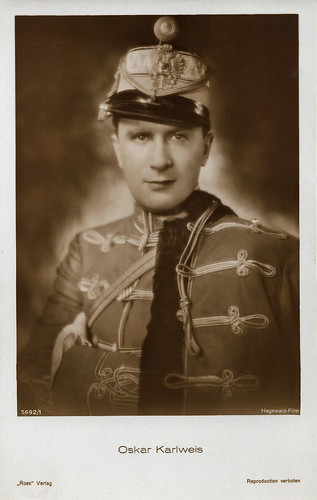
German postcard by Ross Verlag, no. 5692/1, 1930-1931. Photo: Hegewald Film. Oskar Karlweis in Der Tanzhusar/The Dancing Hussar (Fred Sauer, 1931).
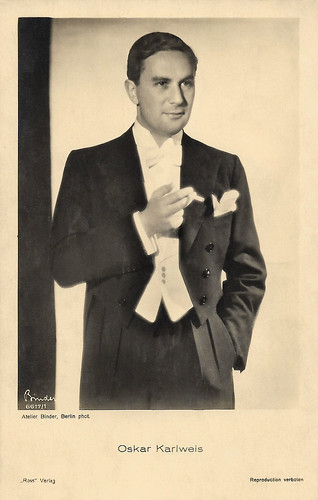
German postcard by Ross Verlag, no. 6617/1, 1931-1932. Photo: Atelier Binder.
Humorous, charming, naive, and cheerful
Oskar Karlweis was born Oscar Leopold Karlweis in 1894 in Hinterbrühl, Austria. Son of the playwright C. Karlweis, the young Oskar abandoned his law studies for the stage.
First he performed for eight years at Vienna's Stadttheater. After service in World War I, he was active with Max Reinhardt's Theater in der Josefstadt in Vienna, followed by engagements at various theatres in Munich and Vienna.
He made his feature film debut in the German silent drama Die Försterchristl/The Bohemian Dancer (Frederic Zelnik, 1926) starring Lya Mara and Harry Liedtke . It was followed by such silent films as Liebe im Kuhstall/Love in the Cowshed (Carl Froelich, 1928) starring Henny Porten .
In 1927 he went to Berlin, where he worked for the Deutschen Theater and was successful in Strauss operetta's like 'Der Fledermaus' and 'Wiener Blut'. His general manner was humorous, charming, naive, and cheerful.
Between 1930 and 1933 he worked in Berlin as a recording artist and acted in more than a dozen film comedies and musicals. These included Zwei Herzen im 3/4 Takt/Two Hearts in Waltz Time (Géza von Bolváry, 1930) starring Irene Eisinger, Ein Tango für Dich/A Tango for You (Géza von Bolváry, 1930) starring Willi Forst , and Die Firma heiratet/The Firm Gets Married (Carl Wilhelm, 1931).
Karlweis was best known as one of Lilian Harvey 's suitors in the hugely successful operetta film Die Drei von der Tankstelle/The Three from the Filling Station (Wilhelm Thiele, 1930), with Willy Fritsch and Heinz Rühmann .
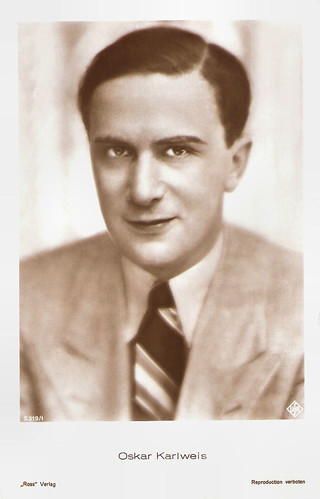
German postcard by Ross Verlag, no. 5319/1, 1930-1931. Photo: Ufa.
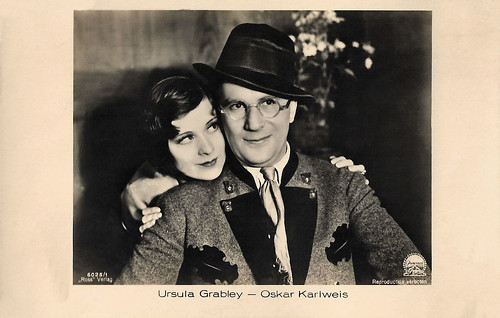
German postcard by Ross Verlag, no. 6025/1, 1931-1932. Photo: Paramount. Ursula Grabley and Oskar Karlweis in Das Konzert/The Concert (Leo Mittler, 1931).
Getting his English legs
With Hitler's rise to power in 1933, Oskar Karlweis, who was of Jewish descent, had to emigrate. He returned to his home country Austria and was able to continue his career at the Kammerspielen and at the Theater in der Josefstadt.
He also appeared in such films as the drama Letzte Liebe/Last Love (Fritz Schulz, 1935) starring Albert Bassermann . With the Nazi Anschluss in 1938 he was again forced to flee, first to Switzerland and then to Paris where, at both locations, he took to the stage with fellow Austrian law school dropout, writer/director, and cabaret performer Karl Farkas.
When German forces took Paris in 1940, Karlweis, along with his friend Austrian writer Friedrich Torberg, fled via Spain to Portugal, whence they made their way to New York.
Not knowing English, Karlweis was at first limited to acting in German emigré productions, but he soon got his English legs and had his first great success in English in 1942 with 'Rosalinda'. He appeared in eight Broadway shows, including the title role in Franz Werfel's long-running 'Jacobowsky and the Colonel,' garnering outstanding reviews.
In 1948, Karlweis returned to Vienna for the first time after the war. In Austria, he was welcomed by an enthusiastic audience. After this successful comeback, he commuted between Austria and the USA in the next years.
In the early 1950s Karlweis played supporting roles in TV productions and in several Hollywood and European films. His films included the American comedy St. Benny the Dip (Edgar G. Ulmer, 1951), the Spy film 5 Fingers (Joseph L. Mankiewicz, 1952) with James Mason , and the German musical comedy Hollandmädel/Dutch Girl (Johann Alexander Hübler-Kahla, 1953) starring Sonja Ziemann .
Oskar Karlweis died in 1956 of a heart attack in New York, and is interred in Vienna. In 1946, he had married theatrical and film producer Ninon Tallon, the niece of three-time Prime Minister of France Édouard Herriot. She continued to use his surname professionally until after his death.
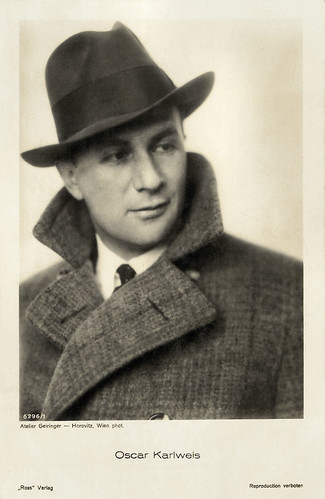
German postcard by Ross Verlag, no. 6296/1, 1931-1932. Photo: Geiringer - Horovitz, Wien (Vienna).
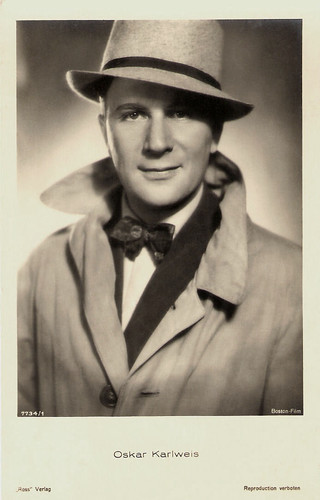
German postcard by Ross Verlag, no. 305. Photo: Boston-Film.
Oskar Karlweis in Heut' kommt's drauf an/Today it depends (Kurt Gerron, 1933).
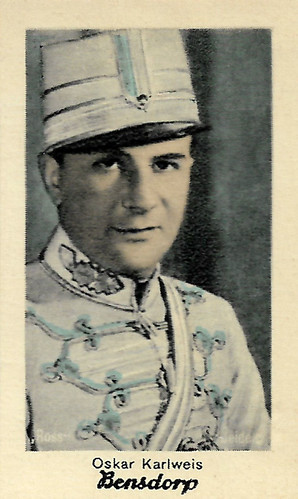
Austrian collectors card by Bensdorp, Wien, Serie G, no. 305. Photo: Ross / Jeide.
Sources: Wikipedia and .

German postcard by Ross Verlag, no. 5692/1, 1930-1931. Photo: Hegewald Film. Oskar Karlweis in Der Tanzhusar/The Dancing Hussar (Fred Sauer, 1931).

German postcard by Ross Verlag, no. 6617/1, 1931-1932. Photo: Atelier Binder.
Humorous, charming, naive, and cheerful
Oskar Karlweis was born Oscar Leopold Karlweis in 1894 in Hinterbrühl, Austria. Son of the playwright C. Karlweis, the young Oskar abandoned his law studies for the stage.
First he performed for eight years at Vienna's Stadttheater. After service in World War I, he was active with Max Reinhardt's Theater in der Josefstadt in Vienna, followed by engagements at various theatres in Munich and Vienna.
He made his feature film debut in the German silent drama Die Försterchristl/The Bohemian Dancer (Frederic Zelnik, 1926) starring Lya Mara and Harry Liedtke . It was followed by such silent films as Liebe im Kuhstall/Love in the Cowshed (Carl Froelich, 1928) starring Henny Porten .
In 1927 he went to Berlin, where he worked for the Deutschen Theater and was successful in Strauss operetta's like 'Der Fledermaus' and 'Wiener Blut'. His general manner was humorous, charming, naive, and cheerful.
Between 1930 and 1933 he worked in Berlin as a recording artist and acted in more than a dozen film comedies and musicals. These included Zwei Herzen im 3/4 Takt/Two Hearts in Waltz Time (Géza von Bolváry, 1930) starring Irene Eisinger, Ein Tango für Dich/A Tango for You (Géza von Bolváry, 1930) starring Willi Forst , and Die Firma heiratet/The Firm Gets Married (Carl Wilhelm, 1931).
Karlweis was best known as one of Lilian Harvey 's suitors in the hugely successful operetta film Die Drei von der Tankstelle/The Three from the Filling Station (Wilhelm Thiele, 1930), with Willy Fritsch and Heinz Rühmann .

German postcard by Ross Verlag, no. 5319/1, 1930-1931. Photo: Ufa.

German postcard by Ross Verlag, no. 6025/1, 1931-1932. Photo: Paramount. Ursula Grabley and Oskar Karlweis in Das Konzert/The Concert (Leo Mittler, 1931).
Getting his English legs
With Hitler's rise to power in 1933, Oskar Karlweis, who was of Jewish descent, had to emigrate. He returned to his home country Austria and was able to continue his career at the Kammerspielen and at the Theater in der Josefstadt.
He also appeared in such films as the drama Letzte Liebe/Last Love (Fritz Schulz, 1935) starring Albert Bassermann . With the Nazi Anschluss in 1938 he was again forced to flee, first to Switzerland and then to Paris where, at both locations, he took to the stage with fellow Austrian law school dropout, writer/director, and cabaret performer Karl Farkas.
When German forces took Paris in 1940, Karlweis, along with his friend Austrian writer Friedrich Torberg, fled via Spain to Portugal, whence they made their way to New York.
Not knowing English, Karlweis was at first limited to acting in German emigré productions, but he soon got his English legs and had his first great success in English in 1942 with 'Rosalinda'. He appeared in eight Broadway shows, including the title role in Franz Werfel's long-running 'Jacobowsky and the Colonel,' garnering outstanding reviews.
In 1948, Karlweis returned to Vienna for the first time after the war. In Austria, he was welcomed by an enthusiastic audience. After this successful comeback, he commuted between Austria and the USA in the next years.
In the early 1950s Karlweis played supporting roles in TV productions and in several Hollywood and European films. His films included the American comedy St. Benny the Dip (Edgar G. Ulmer, 1951), the Spy film 5 Fingers (Joseph L. Mankiewicz, 1952) with James Mason , and the German musical comedy Hollandmädel/Dutch Girl (Johann Alexander Hübler-Kahla, 1953) starring Sonja Ziemann .
Oskar Karlweis died in 1956 of a heart attack in New York, and is interred in Vienna. In 1946, he had married theatrical and film producer Ninon Tallon, the niece of three-time Prime Minister of France Édouard Herriot. She continued to use his surname professionally until after his death.

German postcard by Ross Verlag, no. 6296/1, 1931-1932. Photo: Geiringer - Horovitz, Wien (Vienna).

German postcard by Ross Verlag, no. 305. Photo: Boston-Film.
Oskar Karlweis in Heut' kommt's drauf an/Today it depends (Kurt Gerron, 1933).

Austrian collectors card by Bensdorp, Wien, Serie G, no. 305. Photo: Ross / Jeide.
Sources: Wikipedia and .
Published on August 18, 2019 22:00
Paul van Yperen's Blog
- Paul van Yperen's profile
- 13 followers
Paul van Yperen isn't a Goodreads Author
(yet),
but they
do have a blog,
so here are some recent posts imported from
their feed.



